- 9:35 PM, Tuesday, 05 Aug 2025
- Skip to main content



-
- English
- हिन्दी


The faculty members of IIST are actively involved in carrying out research activities in addition to teaching. This is augmented by the PhD program through which a number of research scholars are carrying out theoretical and experimental research in diverse areas related to sciences, technology and humanities. This is evident from the large number of publications published as well as patents filed and accepted. The recent research activities being carried out in various departments of IIST are highlighted here.
A way to obtain artifact-free correlations between labile sites as well as between labile and non-labile sites – the extended Hadamard scheme, and its performance corroborated with a series of RNA-based measurements in SARS-CoV2 RNA Fragments.
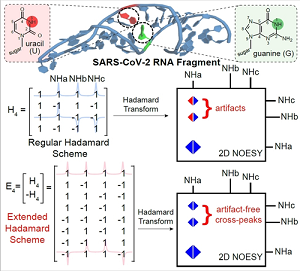 |
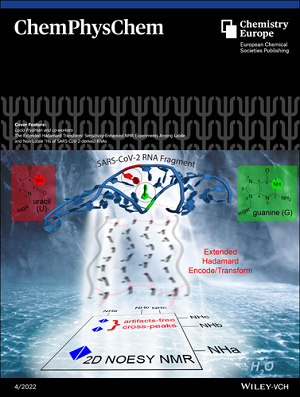 |
Ref: ChemPhysChem, 2022, https://doi.org/10.1002/cphc.202100704 Jihyun Kim, Mihajlo Novakovic, Sundaresan Jayanthi, Adonis Lupulescu, Ēriks Kupče, J Tassilo Grün, Klara Mertinkus, Andreas Oxenfarth, Harald Schwalbe, Lucio Frydman.
Improvement of heteronuclear transfers through J-driven cross polarization (J-CP), which transfers polarization by spin-locking the coupled spins under Hartmann-Hahn conditions. J-CP provides certain immunity against chemical exchange and other T2-like relaxation effects, a behavior that is examined in depth by both Liouville-space numerical and analytical derivations describing the transfer efficiency.
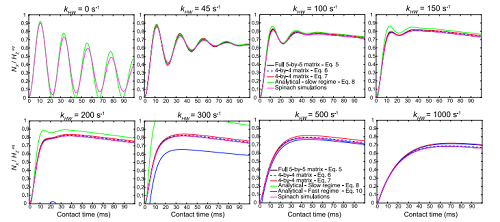 |
Figure: Numerical vs analytical solutions for J-CP as a function of contact time.
Ref: J. Magn. Reson., 333, 2021, 107083, Mihajlo Novakovic, Sundaresan Jayanthi, Adonis Lupulescu, Maria Grazia Concilio, Jihyun Kim, David Columbus, Ilya Kuprov, Lucio Frydman.
In this work, a novel experiment using selective longitudinal Cross Polarization is proposed and demonstrated that enhances the sensitivity and resolution of homonuclear NOESY correlations by targeting selected 1H–15N spin pairs.The enhanced signal sensitivity (~ 2-5) as well as access to both 15N–1H and 1H–1H NOESY dimensions can greatly facilitate RNA assignments and secondary structure determinations, as demonstrated with the analysis of genome fragments derived from the SARS-CoV-2 virus. More details at: https://doi.org/10.1021/jacs.1c01914
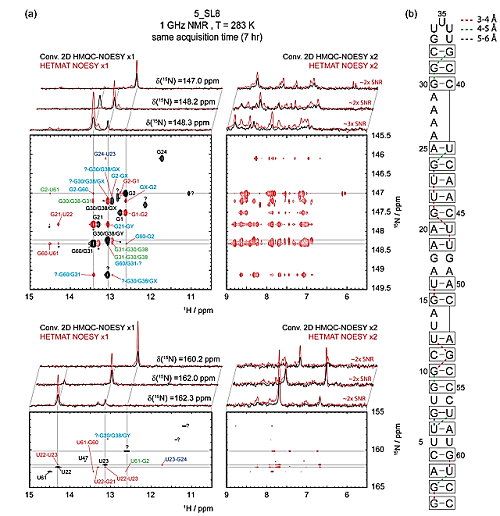 |
Ref: J. Am. Chem. Soc. 2021, 143, 13, 4942–4948; Jihyun Kim, Mihajlo Novakovic, Sundaresan Jayanthi, Adonis Lupulescu, Eriks Kupce, J Tassilo Grün, Klara Mertinkus, Andreas Oxenfarth, Christian Richter, Robbin Schnieders, Julia Wirmer-Bartoschek, Harald Schwalbe, Lucio Frydman.
We investigate in detail the underlying spin-dynamics associated with time-dependent Hamiltonians by developing theoretical models in complex spin systems (1H-14N, 1H-35Cl etc.). In a recent work, published in Journal of Magnetic Resonance we employed matrix logarithm and Floquet theory to compute numerically the effective Hamiltonian associated to a time-dependent problem in solid state Nuclear Magnetic Resonance, Cross-Polarization under fast Magic Angle Spinning (MAS) and Double Cross Polarization under fast MAS. A detailed analytical solution of the associated time-dependent problem is challenging due to the interference between large 14N time-dependent quadrupolar interaction and 14N RF irradiation. The structure of the effective Hamiltonian was found to exhibit a strong dependence on crystallite orientation, with several spin terms of comparable magnitude present for most crystallite orientations. A comprehensive insight on 1H-14N CPMAS and double CP spin dynamics was presented through numerical simulations, and the observations are substantiated with analytical derivations
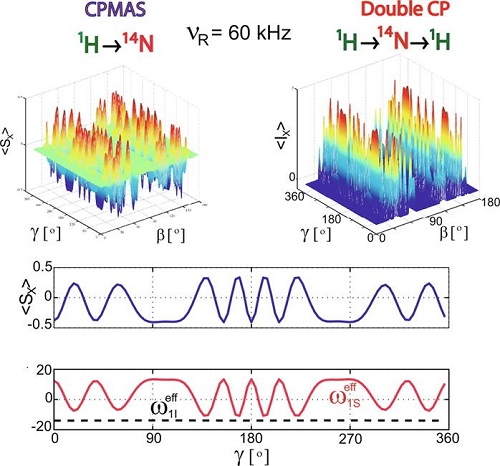 |
Figure:- CP-MAS signals arising from a powder showing Destructive interference and Double CP MAS signals showing constructive interference. Matching conditions for CP transfer is shown below.
Ref: "Effective Hamiltonian and 1H-14N cross polarization/double cross polarization at fast MAS"; J. Magn. Reson., 320, 106832, 2020; Sadasivan V. Sajith, Sundaresan Jayanthi, Adonis Lupulescu
[Funded by SERB: Govt. of India: 2016-2019; Project Investigator - S. Jayanthi]
One of the major goals of studying materials and biomolecules is establishing relation between structure and functions. Nuclear magnetic resonance (NMR) spectroscopy is a versatile and non-invasive analytical tool for probing molecular level structure and dynamics. In this project solid state proton and deuterium MAS NMR spectroscopy is utilized to get insight on features of hybrid functionalised mesoporous materials. Dynamics thus derived of the confined guest molecules or functionalized molecules are essential as they are correlated to their functions.
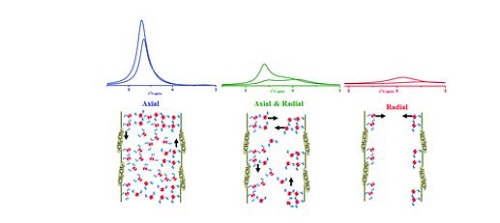 |
Ref: V S Veena, Illath Kavya, Lazar Anish, C P Vinod, T G Ajithkumar, S Jayanthi; Phys. Chem. Chem. Phys., 2018, 20, 29351-29361
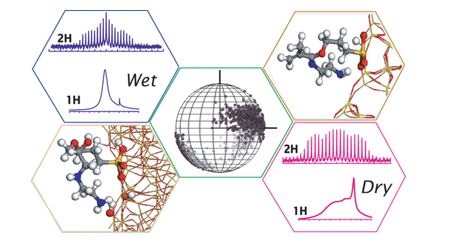 |
Ref: V S Veena, Illath Kavya, Lazar Anish, C P Vinod, T G Ajithkumar, S Jayanthi; J. Phys. Chem. C 2020, 124, 11, 6154–6170.
The dynamics of quantum systems play an essential role in quantum information processing and computing. We have studied the dynamics of superposition of wavepackets evolving under different nonlinear Hamiltonians corresponding to Kerr medium, Morse oscillator, and bosonic Josephson junction. We have shown that quantum systems' periodic, quasi-periodic, ergodic, and chaotic dynamics can change drastically if we change just the initial state to its superposition by keeping all other system parameters the same. Our initial analysis shows some relation between the interference of the initial state and its dynamics, but a detailed analysis is required to establish a definite connection between them.
We attempted to understand how the q-deformation of ordinary Hamiltonian changes the system’s behaviour. The q-deformation confers non-linear properties to the ordinary quantum harmonic oscillator. By studying the dynamics of the resultant times series obtained for the expectation values of the dynamical variables, we conclude that the system studied exhibits periodic, quasi-periodic, and chaotic behaviour depending on the deformation parameter and the deformed coherent amplitude. As the deformation parameter and amplitude value increase, we observe that chaotic nature is the more prominent dynamical behaviour. For lower values of the parameters, the dynamical behaviour is mostly quasi-periodic.
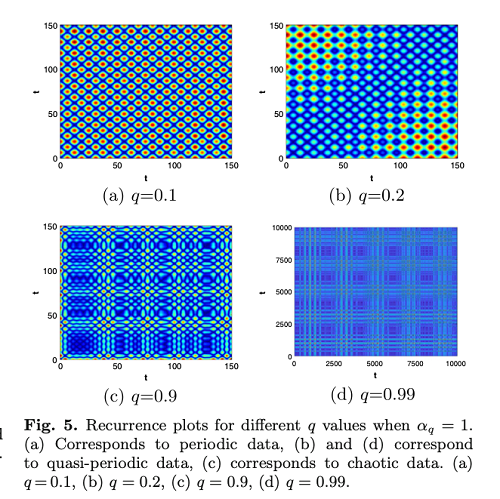 |
Figure:- Recurrence plots for different q values when αq = 1. (a) Corresponds to periodic data, (b) and (d) correspond to quasi-periodic data, (c) corresponds to chaotic data. (a) q = 0.1, (b) q = 0.2, (c) q = 0.9, (d) q = 0.99.
Ref: Dynamics of observables in a q-deformed harmonic oscillator, A. Pradeep, S. Anupama, C. Sudheesh, Eur. Phys. J. D. 74, 3 (2020), https://doi.org/10.1140/epjd/e2019-100436-y.
Ref: Nonlinear dynamics of superposition of wavepackets, S. Kannan, M. Rohith, C. Sudheesh, Eur. Phys. J. Plus 137, 471 (2022), https://doi.org/10.1140/epjp/s13360-022-02673-z.
We have studied the squeezing properties of arbitrary numbers of superpositions of various squeezed states such as squeezed vacuum state, photon-added coherent states, and two mode squeezed vacuum state. We have considered two superpositions: the first kind and the second kind. In the case of the first kind, the superpositions of squeezed states do not show both squeezing and higher-order squeezing of all orders. This is found to be true for any state which has quadrature squeezing and multi-mode squeezed states. However, in the case of the superpositions of the second kind (also called generalized superpositions), it has been shown that the superposition states show significant amounts of quadrature and higher-order squeezing. This is achieved by choosing the proper weight factors in the superpositions; this method also enables us to control over the amount of squeezing produced.
The vanishing and appearance of squeezing in a superposition state are explained based on expectation values of energy density or stress-energy tensor. States with squeezing are shown to have a negative expectation value for the stress-energy tensor for some values of spacetime-dependent phase. In the case of states with no squeezing, the expectation values of energy density is always positive.
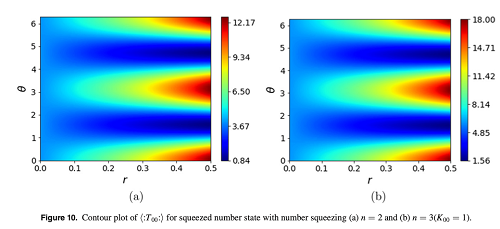 |
Figure:- Contour plot of <:T00:> for squeezed number state with number squeezing (a) n=2 and (b) n=3 (K00=1)
Ref: Squeezing and nonclassicality of q-deformed superposition states, S. Anupama, S. Kannan, C. Sudheesh, Eur. Phys. J. D 76, 11 (2022), https://doi.org/10.1140/epjd/s10053-021-00337-8.
Ref: Disappearance of squeezing in superposition states and its manifestation in the energy density, S. Kannan, C. Sudheesh, J. Phys. B: At. Mol. Opt. Phys. 55, 095403 (2022), https://doi.org/10.1088/1361-6455/ac6846.
We have found the quadrature operator eigenstates and wavefunctions for the general f-deformed oscillators. We have defined the f-deformed quadrature operator with the help of the homodyne detection method and represented its eigenstates in the f-deformed Fock state basis. This allowed us to produce a recurrence relation for the wavefunctions, which in turn allowed us to discover a new class of orthogonal polynomials. These new polynomials enabled us to represent the excited state wavefunctions of the f-oscillators in terms of the ground state wavefunction. Three types of deformed systems, namely math-type q-deformation, physics-type q-deformation, and (p,q)-deformation, were studied. We constructed the quantum states
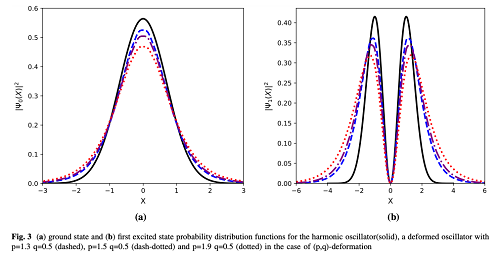 |
Figure:- (a) Ground state and (b) first excited state probability distribution functions for the harmonic oscillator (solid), a deformed oscillator with p=1.3 q=0.5 (dashed), p=1.5 q=0.5 (dash-dotted) and p=1.9 q=0.5 (dotted) in the case of (p,q)-deformation of target space coordinates from world-sheet states using quantum state tomography.
Ref: Quadrature operator eigenstates and energy eigen functions of f-deformed oscillators, S. Anupama, A. Pradeep, A. Pal, C. Sudheesh, Indian J. Phys. (2022), https://doi.org/10.1007/s12648-022-02286-3.
Ref: Construction of Quantum Target Space from World-Sheet States using Quantum State Tomography, SS Wani, A Shabir, JU Hassan, S Kannan, H Patel, C Sudheesh, M Faizal, Annals of Physics 441, 168867 (2022), https://doi.org/10.1016/j.aop.2022.168867
The superposition principle applies to several physical problems. When the problem involves two or more degrees of freedom, the notion of entanglement emerges, as elucidated by Erwin Schroedinger in 1935. Quantum information processing, quantum communication, and quantum computation, have their basis on entanglement, a consequence of the superposition principle. An even more elementary consequence of the superposition principle, as seen in optics
 |
experiments, is the formation of fringes that are readily observed on a screen. An instance being, Newton’s rings of Sir Isaac Newton’s fame, observed since 1664. Both entanglement and fringe formation are consequences of the superposition principle. Is there a connection? A table top experiment recently carried out at the Applied and Adaptive Optics lab, Department of Physics IIST, demonstrated this link, that is : fringe movement under some considerations, implies Polarisation-spatial entanglement. The experiment reported maximal two qubit entanglement.
Ref: Soumya Asokan and J Solomon Ivan, Gaussian spatial-polarization entanglement in a folded Mach-Zehnder interferometer, Journal of Optical Society of America A, Vol.37, No.5, 825-832, April (2020).
This work resolves the separability/entanglement issue exactly for a class of bipartite states.
Ref: S Asokan and J Solomon Ivan, JOSA A, Vol 38, No. 9, 1304-1311, September 2021.
Was an Editor's pick.
This work improves upon the best known theoretical limits of phase sensitivity as obtained through intensity measurements in a Mach-Zehnder interferometer.
Ref: J Ramakrishnan and J Solomon Ivan, Quant. Inf. Process. 10.1007/s11128-021-03376-7, January 2022.
A novel method is proposed and demonstrated experimentally to retrieve the 2D as well as the 3D complex object from its autocorrelation. The method utilizes edge point referencing, therefore, does not require any separate reference to record the hologram. Being common-path, it is robust to external vibrations. The employment of the amplitude shifting in the proposed setup as opposed to phase shifting also avoids using expensive components required to perform phase shifting operation. By choosing the reference point at the desired/illuminated object boundary leads to two-fold improvement in the field-of view as compared to that in off-axis holography. In addition, by keeping the reference point at the desired/illuminated object boundary reduces the highest frequency content (spatial carrier fringes) in the hologram leading to better sampling of the hologram/ recording larger size hologram with same size and pixel resolution of a CCD camera as compared to that in off-axis holography. The proposed method also shows great potential in some practical applications such as in measuring the real time deformation.
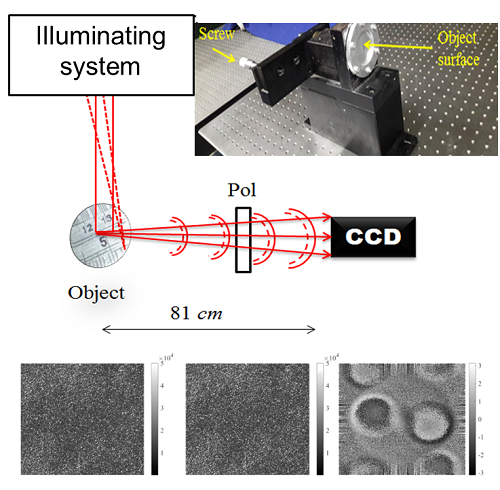 |
Ref: Surya Kumar Gautam, Rakesh Kumar Singh, C. S. Narayanamurthy, and Dinesh N. Naik “Reconstruction of complex-object using edge point referencing,” Journal of Optics, 22, 055601 (2020).
Asymmetry in the object is used as a tool to eliminate the twin-image problem. By carrying out the simulations as well as the experiment, the validity of the proposed scheme has been proven. The proposed method only requires calculating the object support information. For most of the objects, the support information can be retrieved from the object autocorrelation itself without requiring additional measurements.
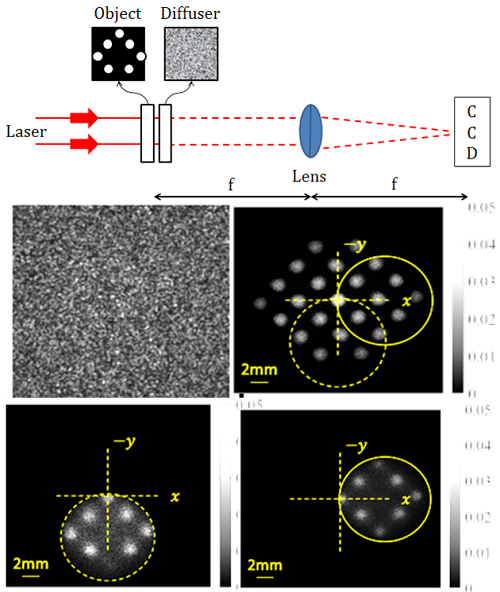 |
Ref: Surya Kumar Gautam, Rakesh Kumar Singh, C. S. Narayanamurthy, and Dinesh N. Naik “Single-shot and twin-image free unique phase retrieval using an aspect of autocorrelation that considers the object asymmetry” JOSA A , 37, 1826-1831 (2020).
The variation in phase of the resultant field being non-linearly related to the changes in phase difference between the interfering complex fields, the ensuing enhancement in sensitivity for phase detection in optical metrology is achieved.
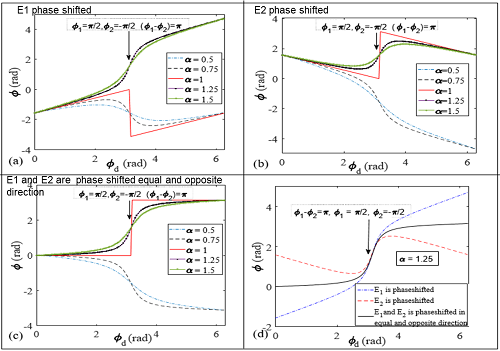 |
Ref: T S Athira, Dinesh N Naik, “Amplified sensing of optical phase difference through the phase of the resultant field”, J. Opt. 23 115606, 2021.
Carbon foams are light weight thermos-structural materials used for high temperature thermal protection, fire resistant structures, EMI shielding and acoustic absorption. They are produced by the foaming, setting and carbonization of synthetic organic polymers and pitches. Biomasses are naturally renewable plant based materials available in large quantities at low cost. Sustainable development demands a shift from petroleum based raw materials to biomasses for the production of advanced materials. We have developed green filter-pressing process for the preparation of carbon composite foams from biomasses such as natural cotton, newspaper waste, sawdust and rice husk using sucrose as a carbonaceous binder. The carbon composites of various densities could be produced from each biomass by varying the sucrose solution concentration used for filter pressing. The produced carbon composite foams exhibit low thermal conductivity, reasonably high compressive strength, excellent fire resistance and very high EMI shielding properties.
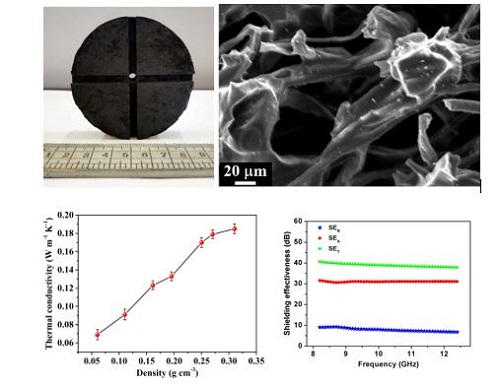 |
Ref: A. Chithra, P. Wilson, S. Vijayan, R. Rajeeev and K. Prabhakaran, Thermally insulating robust carbon composite foams with high EMI shielding from natural cotton, Journal of Materials Science and Technology, 94 (2021) 113-122.
A fluorescence sensor for basic amino acids based on WS2 nanosheets- silver oxide nanoparticles (WS2 NSs-Ag2O NPs) composite materials has been developed. The composite was prepared via the in situ formation of silver oxide nanoparticles (Ag2O NPs) by the combined action of fluorescent WS2 nanosheets (WS2 NSs) in the presence of NaOH. The fluorescence of WS2 NSs was quenched upon the formation of Ag2O NPs due to resonance energy transfer. The obvious spectral overlap of WS2NSs emission with that of surface plasmon resonance (SPR) absorption of Ag2O NPs explains the non-radiative energy transfer. The quenched fluorescence was selectively recovered in the presence of three basic amino acids; His, Lys and Arg, at a pH below the isoelectric point of each amino acid. The fluorescence recovery was attributed to the aggregation of Ag2O NPs and thereby the lack of spectral overlap between WS2NSs and Ag2O NPs. The formation of Ag2O NPs, the comprehensive mechanism of quenching and the fluorescence recovery. The real sample analysis was demonstrated using biological fluids.
 |
Ref: Neema Pallikkarathodi Mani, Karthika S Sunil, Ann Mary Tomy, Bhasha Sathyan and Jobin Cyriac (2022) Detection and screening of basic amino acids using the luminescence switching of WS2 nanosheets- Ag2O nanoparticles composite. Sensors & Diagnostics, 2022, DOI: 10.1039/D2SD00009A
The modern society and recent scientific developments inextricably depend on the effective energy storage systems. Lithium-sulfur battery (LSB) received the attention of researchers due to its high theoretical capacity of 1675 mAh g-1 through the electrochemical reaction between lithium and sulphur. Polysulfide shuttle is a major challenge to be addressed while designing LSBs as it stagnates the overall performance of the system. The exploration of better material combinations is imperative to deal with the issue. With this objective, a grain-like lithium cobalt vanadate embedded graphene nanoplatelets (GLCVO) is designed as a potent sulfur host in LSBs. The composite cathode with preferable active sites is found to be highly efficacious in capturing the polysulfides through strong chemical interaction. Simultaneously, GLCVO composite with intrinsic catalytic property propels the polysulfide conversion reaction kinetics. Furthermore, the graphene nanoplatelets render an interconnected pathway for electronic conduction. As a direct consequence, the fabricated coin cell evinces an initial discharge capacity of 982 mAh g-1 at 0.5 C rate and maintains excellent cyclability with a low attenuation rate of 0.031% over 500 cycles. Besides, the cell exhibits better static stability and attenuates the self-discharge behaviour to a great extent. The detailed structural and electrochemical evaluation cooperatively reveals its excellent electrochemical properties which makes it an attractive cathode material for LSBs.
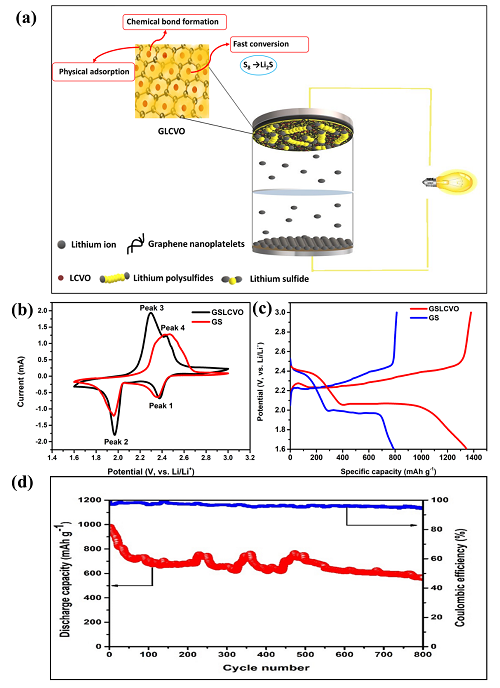 |
Fig. (a) Schematic illustration of the polysulfide confinement mechanism in GSLCVO cell; (b) CV curves of GS and GSLCVO cells; (c) initial charge-discharge profiles of GS and GSLCVO cells at 0.1 C; (d) Long-term cycling performances of GSLCVO cell at 0.5 C.
Ref: Sreekala K., Haritha H., Mary Gladis J., Efficient polysulfide shuttle mitigation by graphene-lithium cobalt vanadate hybrid for advanced lithium-sulfur batteries, J. Electroanal. Chem. 899 (2021) 115665. https://doi.org/10.1016/j.jelechem.2021.115665.
High-performance electromagnetic interference (EMI) shielding materials that are very elastic and flexible, hydrophobic, and of low density are required to address the rising electromagnetic pollution problem.
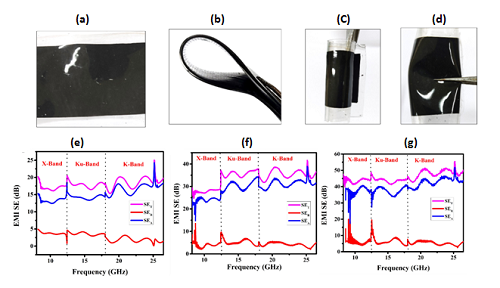 |
Photographs of CBSP@CNFs PDMS composite (a-d), EMI SE of CBSP@CNFs (e) and CBSP@CNFs (e) and PDMS composites (f-g)
Carbon nanofibers (CNFs) incorporated with carbon black super P (CBSP@CNFs) and their polydimethylsiloxane (PDMS) composites were fabricated using a combination of electrospinning followed by heat treatment and manual lay-up process. The high electrical conductivity of 2.5 S cm-1 imparted excellent EMI shielding property to CBSP@CNFs. With a thickness of 0.06 mm and a density of 0.63 g cm-3, CBSP@CNFs exhibited high EMI shielding effectiveness (EMI SE) over a wide frequency range (8.2-26.5 GHz). The highest and average values of EMI SE in the range were 55.8 and 50.7 dB respectively. Composites of CBSP@CNFs with PDMS also showed similar behaviour, which is remarkably higher than the most reported EMI shielding materials. These results suggest that CBSP@CNFs and their PDMS composites would be promising for applications as thin, flexible, stretchable, and light weight EMI shielding materials.
Ref: Sharma GK, James NR (2022). Carbon black incorporated carbon nanofiber based polydimethylsiloxane composites for electromagnetic interference shielding. Carbon Trends (8) 100177. https://doi.org/10.1016/j.cartre.2022.100177
We developed a design strategy to bridge the gap between aggregation-caused quenching (ACQ) and aggregation induced emission (AIE) in fluorophores by developing a novel class of dual state emissive (DSE) full color tunable molecules. Computational chemistry assisted core design predicted stable conformers and the effects of steric and various supramolecular interactions were evaluated. The C4 substituent acted as multifunctional stacking modulator. The designed novel molecules were synthesized and evaluated for photophysical properties to confirm their DSE behaviour with striking quantum yield both in solution and solid states. Importantly, molecules exhibited a very rare full color dual emission in both states (solution: 469-672nm, solid: 466-614nm) thus becoming new entrants in the full color dual state emissive (FCDSE) family, which amplifies their potential use in technological applications.
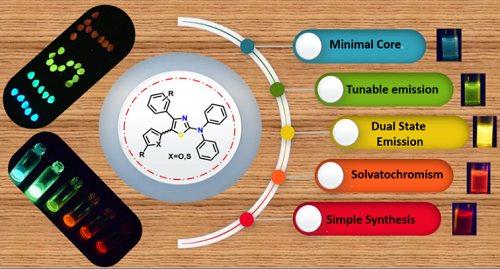 |
Figure: Graphical abstract from the publication*
Ref: Rakesh R, Bhavya BS, Vishnu A, K.G. Sreejalekshmi: Discovery of full color emissive thiazole fluorophores in solution and solid states: The core is central and regulating torsional barrier does the trick!, Dyes and Pigments, 181, 2020, 108560. ISSN 0143-7208, https://doi.org/10.1016/j.dyepig.2020.108560*
During these pandemic times, in response to the global call for identifying and characterizing specific and potent SARS-CoV-2 antivirals, we conducted in silico screening of an in-house library to assess its furin inhibition potential. Molecular docking studies indicated zero generation EDA cored PAMAM dendrimer and its guanylthiourea derivatives as potential furin inhibitors. Interestingly, the dendrimer conjugate masks furin’s substrate binding site and hence would prevent the binding of furin to spike protein. Further, molecular dynamics (MD) simulation revealed PAMAM and its conjugates to bind to the catalytic triad of furin. Further biological evaluations are in progress.
Ref: Chithra R Nair and KG Sreejalekshmi: Presented in the Drug Discovery Hackathon 2020, the open source drug discovery Hackathon against Covid-19), a joint initiative of AICTE, CSIR and supported by Office of Principal Scientific Advisor, Govt. of India, NIC and MyGov.
In line with the Human in Space Program (HSP), spaceflight hardware design for Drosophila experiment was completed, prototype was built and used for validation. Experimental verification tests using Drosophila kidney stone models are in progress.
For assisting in gravitational biology research, development of microgravity simulators were initiated. As part of an MTech project, a Random Positioning Machine was designed, fabricated, and tested for microgravity science experiments. The platform is now being used for conducting of microgravity science experiments using plants and other biological samples.
Ref: Sathasivam M, Hosamani R, K Swamy B, K G Sreejalekshmi; Life Sciences in Space Research, 2020, 28:74-86: DOI: 10.1016/j.lssr.2020.10.001 PMID: 33612182
Nanomaterials are cornerstones of nanoscience and technology and have created a high interest in recent years by virtue of their unusual and unique properties and the various potential applications. It has found wide range of applicability in various fields such as sensors, opto-electronic devices, energy storage, bio imaging, and water treatment to name a few. Sensors based on nanomaterials, rely on the highly active surface and the high specific surface area to initiate a response even with a minute change of concentrations of the analyte species, thus enabling highly efficient sensors. Electrochemical (EC) sensor based on nanomaterials are proved to be highly efficient. Certain nanomaterials like Graphene, transition metal chalcogenides, Mxenes etc have proven to be highly applicable because of their additional property such as improved conductivity and stability. Our group focuses on selecting nanomaterials based on the interactions between the electrode materials and the analytes of choice and applying the materials for EC sensing. Our group focus is to devise or adapt synthetic strategies which are simple, cost effective and benign to the environment. We have done works based on nanomaterials such as 2D layered materials, graphene, graphene quantum dots and metal nanoclusters. Figure 1 gives the schemes of some of the EC sensing research done by our group
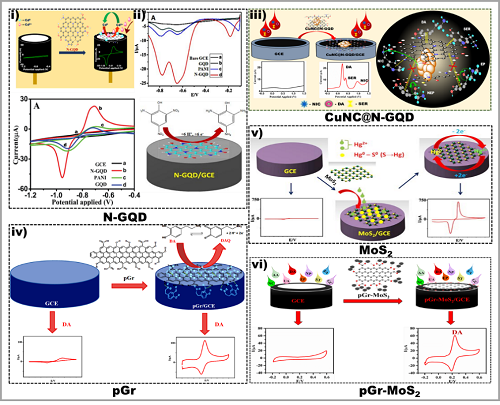 |
Figure 1. A schematic of the EC sensing performance of different nano-functional materials on various analytes of choice.
Ref.: S. Saisree, R. Aswathi, J. S. Arya Nair and K. Y. Sandhya, New J. Chem., 2021, 45, 110-122; Ramachandran, A.; Arya N. J. S.; Karunakaran, Y. S. ACS Sustain Chem Eng. 2019, 7, 6732-6743.;
Ref: Saisree S., Arya Nair J. S. and Sandhya K. Y. J. Mater. Chem. B, 2022.; Ramachandran, A.; Panda, S.; Karunakaran Y. S. Sensors Actuators, B Chem. 2018, 256, 488-497.;
Ref: R. Aswathi and K. Y. Sandhya. J. Mater. Chem. A, 2018, 6, 14602-14613.;
Ref: Nair, J. A., Saisree, S., Aswathi, R., & Sandhya, K. Y. (2022). Sensors and Actuators B: Chemical, 354, 131254
The pollution of the majority of the world's water sources and the consequent looming clean drinking water free of pollutants and groundwater pollution which threatens the human and the ecosystem are some of the major concerns faced by the world. The various contaminants from different industrial, agricultural and domestic sources such as pesticides, other chemical contaminants, the heavy metal ions: Hg (II), Pb (II), Cd (II), and As (III) which pollute the water sources are highly toxic and are capable of causing life-threatening diseases to humans. Cost-effective adsorbent materials with high metal ion-removal efficiency and selectivity are considered necessary for the successful removal of these contaminants from water. Our group has studied the removal of heavy metal ions contamination from drinking water because of their high-level toxicity and the ultra-low safe level (Hg (II) ≤ 2ppb, Pb (II) ≤ 10 ppb, Cd (II) ≤ 5 ppb) in water which is very challenging to achieve. In order for this we have utilized molybdenum disulfide (MoS2)/graphene-based materials for the removal of toxic metal ions: Hg (II) and Pb (II) with very high selectivity and efficiency. One of the materials synthesized, MoS2-hollow nano roses (HNR) achieved ~ 99.99 % removal of Hg (II) from environmental water samples spiked with 10000 ppb within ≤ 5 minutes, and another material, partially reduced graphene (prGO)-MoS2 nanocomposite), decreased the [Pb (II)] to ≤ 1 ppb in and ≤ 3 minutes, respectively, with a single treatment. Figure 2 gives an overview of some of the adsorption results from our group
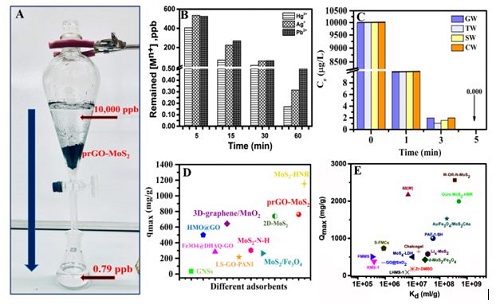 |
Figure. (A): Demonstration of Pb (II) ions removal from environmental water samples using a miniature lab filter setup, where the Pb-contaminated water was passed through a column of prGO-MoS2 within a time of 3 minutes; (B): Selective adsorption performance of MoS2-HNR for separating Hg (II), Ag (I) and Pb (II); (C): The results showing the ultra-fast purification of environmental water samples contaminated with Pb (II) (10,000 ppb) within 3 minutes by 0.5 mg/mL prGO-MoS2; and (D-E): Comparisons of Pb (II) and Hg (II) (saturation uptake capacity Qmax) for prGO-MoS2 and MoS2-HNR with various advanced adsorbents from the literature.
Ref: Arya Nair, J. S., Aswathi R, Saisree, S., & Sandhya, K. Y. Advanced Sustainable Systems, 2200039, 2022;
Ref: Arya Nair, J. S., Saisree, S., & Sandhya, K. Y. (2020). Applied Materials Today, 20, 100642, 2020.
In an electrochemical sensor, the electro catalytic activity of the electrode plays a significant role in sensing analytes at a low concentration. The electro catalytic property of the electrode depends on the electron transfer at the electrode/electrolyte interface, surface area, and electrical conductivity of the electrode material. Though the graphene-based materials have a large surface area, fast electron transfer, and excellent electrical conductivity and have great application potential in chemical/biological sensors, they suffer limitations due to restacking. Hybrid graphene synthesized by incorporating graphene nanoribbon carbon spacers can overcome this limitation and enhance the hybrid material's surface area and electron mobility. We have synthesized the hybrid graphene consisting of graphene sheets and graphene nanoribbon (GS/GNR) modified with N2/Ar plasma treatment (N2/Ar/GS/GNR) and applied as electrode material for the simultaneous detection of dopamine, uric acid, ascorbic acid.
Metal-organic frameworks (MOFs) are an emerging class of highly ordered crystalline materials with a porous structure formed by the association of metal ions (or clusters) and multifunctional organic linkers. MOFs have drawn a considerable amount of research interest in recent years because of their excellent properties like high porosity, large specific surface area, highly dispersed metal components, presence of numerous unsaturated metal centers, and chemical tunability. We are working on the three categories of MOF-based materials synthesized, namely, (i) composite of MOF (Ni-MOF/RGO) and (ii) bimetallic MOFs (Ru-Cu-TMA and Ag-Cu-TMA), Zr and Ni-based MOFs with various organic ligands, and (iii) MOF derived carbon. A composite of MOF material formed by the interaction of MOF and RGO preserves the inherent advantages of both while solving the poor conductivity of MOF. The synergic effect arose from the combination of the materials yields composites with enhanced electrical conductivity, high specific surface area, and multi-channels for ion transport for electrochemical sensing applications and applied for electrochemical sensing of caffeine. v
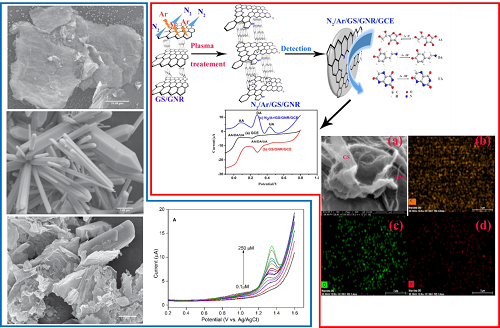 |
Fig: Left: Ni-MOF/RGO based electrochemical sensor for the detection of caffeine, Right: N2/Ar/GS/GNR/GCE biosensor for the simultaneous detection of AA, DA, and UA
Ref: Varsha M. V. and Gomathi N, J. Electrochem. Soc. 167 (2020) 137505).
Ref: Lavanya J, Neogi S, Jaganathan S K, Gomathi, Biosensors and Bioelectronics 105 (2018) 236–242).
Epoxy is one of the most used thermosetting polymers with lots of potential applications, but the brittleness of the cured epoxy composites is a major drawback that limits its usage. Prof. Kuruvilla Joseph’s group is extensively working on this area for last decade with an aim to develop toughened epoxy nanocomposites with improvement in fracture toughness with out a trade-off in other comprehensive properties. For this the group came up with design and synthesis of novel toughening agents, that will contribute to the overall property improvement of epoxy thermosets.
Ref: RBDS Deeraj, JS Jayan, A Saritha, K Joseph, Electrospun Fiber-Reinforced Epoxy Composites, Handbook of Epoxy/Fiber Composites, 1-32 (2022)
Ref: JS Jayan, K Pal, A Saritha, BDS Deeraj, K Joseph, Graphene oxide as multi-functional initiator and effective molecular reinforcement in PVP/epoxy composites, Journal of Molecular Structure 1230, 129873 (2021)
Due to the explosive growth of electronic devices, EMI shielding has become of the most extensively studied research area. Prof. Kuruvilla’s Group is actively working on this area, with an objective to develop lightweight and flexible EMI shields. The group has come up with nanofiller loaded electrospun carbon fibers and their composites for effective and efficient EMI shielding, especially in the high frequency range. The group has developed ultra slim fiber mats with excellent shielding potential that can act as excellent polymer reinforcement.
Ref: BDS Deeraj, G George, NR Dhineshbabu, S Bose, K Joseph, Electrospun ZrO2@ carbon nanofiber mats and their epoxy composites as effective EMI shields in Ku band, Materials Research Bulletin 144, 111477 (2021)
Ref: BDS Deeraj, MS Mathew, J Parameswaranpillai, K Joseph, EMI shielding materials based on thermosetting polymers, Materials for Potential EMI Shielding Applications, 101-110 (2020)
Carbon fibers are the widely used reinforcements in fiber reinforced composites owing to their excellent properties. But they are expensive and we mostly depend on other countries for procuring them. To address this important issue, Prof. Kuruvilla’s group started investigating other polymer sources for preparation of the carbon fibers. Recently, the group has come up with the preparation of lignin-based carbon fibers and PVDF based carbon fibers, by various optimizations. These prepared carbon mats provide tremendous scope for futuristic applications.
Ref: Fathima S, BDS Deeraj, G George, K Joseph Coir Pith Lignin as a reliable bio-source for Carbonaceous Nano-structures: Extraction and characterization, Current Applied Polymer Science (Provisionally accepted, 2022)
Prof. Kuruvilla’s group has come up with different protein protected nanoclusters for bio-sensing applications. The group has explored various preparation strategies and has tested the sensing ability of the prepared materials. The group is currently focusing on green and hybrid combinations of nanomaterials for sensing of biomolecules as well as extending its utility towards drug delivery.
Ref: MS Mathew, A Saritha, K Joseph, Biosensor and Drug Delivery Application by the Utilization of Green Nanotechnology, Green Nanomaterials: Sustainable Technologies and Applications, 113-130 (2022)
Controllability is one of the fundamental properties of control systems which guarantees the ability of the system to be steered from any initial state to a desired final state by using suitable control functions. Controllability analysis for stand-alone systems linear systems has been extensively carried out in the literature. However, for nonlinear systems as well as systems with various other effects like delay, impulses, noises, fuzziness etc in state or control are to be explored for investigation. Also, when several linear systems are connected to form a networked system, the controllability analysis happens to be more non-trivial. Using the tools of functional analysis like spectral theory, fixed point theory, monotone operator theory we carry out controllability analysis of linear as well as nonlinear Systems.
Various types of stability analysis of nonlinear dynamical systems in connection with continuous neural network systems are investigated. The LMI tools and the method of Lyapunov functionals are being employed for the analysis.
To understand the dynamics of WSB trajectories and develop algorithms to obtain WSB trajectories from Earth to Moon and Mars. The role of periodic orbits (PO) and manifolds associated with them in ballistic lunar capture is studied. As a first step towards orbiter missions, planar fly-by trajectories to the Moon were studied in the framework of Restricted three-body problem (RTBP). We attempt the construction of a WSB trajectory toMoon in the restricted four-body problem (RFBP) and its dynamics. An algorithm is developed to obtain WSB trajectories to the moon in a full force model.
Dynamics of micro particles in fluids and the change in rheological parameters due to particle dynamics occur across many industries including many processes relevant to space programs. We developed solutions for some of the problems and the study will be continued. A set of ordinary differential equations governing the migration of an arbitrary forced spheroid in quiescent/ simple-shear/ uniform/ oscillating/ oscillating-shear flows at low Reynolds number is formulated and discussed, assuming a sufficiently diluted suspension to neglect the particle-particle interactions. We study the dependence of the size and shape of the attractor on the controlling parameters such as aspect-ratio, Reynolds-number, amplitude and frequency of the external force and initial orientations or positions of the suspension. We also discuss the fundamental physics of the problem. The dependencies of oscillations on the parameters can be utilized for better separation of particles or for characterizing the suspension. The results of our analysis can be used to validate complex software developed for suspension flow problems. Development of such a system would be of considerable technical and economical significance.
We first consider thin piezoelectric shallow shells with variable thickness and show that the eigenvalues of the three dimensional problem are order square of thickness the corresponding scaled eigensolutions converge to the eigensolutions of a two dimensional model. We then consider flexural shells (for eq: if the middle surface is a plate or if it is flat in a small region or cylindrical shells etc) with variable thickness and show that if the space of inextensional displacement is infinite dimensional, then the eigenvalues are of order square of thickness and the corresponding eigensolutions converge to the eigensolutions of two dimensional flexural shell model.
Information geometry is a branch of Mathematics that applies the techniques of differential geometry to the field of probability theory. The family of probability distributions which constitutes a statistical model has a rich geometric structure as a manifold with Riemannian metric and dual connections. Using this geometric interpretation one can obtain new insight into the framework of statistical inference and can develop new techniques for inference. In the geometric aspects of statistical manifolds, our effort is to understand (i) geometry of immersions and statistical manifolds (ii) geometry of submersions and statistical manifolds, and (iii) tangent bundles and harmonic maps of statistical manifolds. In the case of immersions into statistical manifolds, a necessary and sufficient condition for the inherited statistical manifold structures to be dual to each other is obtained. Then, statistical immersion is defined and proved a necessary condition for a statistical manifold to be a statistical hypersurface. Its converse is also proved. A necessary and sufficient condition for the inherited statistical manifold structures to be dual to each other is proved for a centro-affine immersion of codimension two into a dually flat statistical manifold. Then proved that the inherited statistical manifold structure is conformally-projectively flat in this case. We introduced the concept of a conformal submersion with horizontal distribution for Riemannian manifolds, which is a generalization of the affine submersion with horizontal distribution. A necessary condition for the existence of such a map is proved. Then compares the geodesics for a conformal submersion with horizontal distribution. A necessary and sufficient condition for the horizontal lift of a geodesic to be geodesic is obtained. In the case of conformal submersion with horizontal distribution, proved a necessary and sufficient condition for (M, ∇, gm) to become a statistical manifold. We obtained a necessary and sufficient condition for the tangent bundle TM to be a statistical manifold with the complete lift connection and the Sasaki lift metric. Then, proved a necessary and sufficient condition for the harmonicity of the identity map for conformally-projectively equivalent statistical manifolds. The conformal statistical submersion is defined which is a generalization of the statistical submersion and proved that harmonicity and conformality cannot coexist. Then, given a necessary condition for the harmonicity of the tangent map with respect to the complete lift structure on the tangent bundles. Also, proved a necessary and sufficient condition for the tangential map to be a statistical submersion.
Phase type (PH) distributions, which are defined on the non-negative real line, became quite popular in the last decades as they have been used in a wide range of applications of stochastic models. It forms a dense subset in the space of all distributions defined on the non-negative real numbers and at the same time it is numerically tractable because of its underlying Markovian structure. We could find a multivariate distribution, defined on any k-orthotope in [0,∞)k , having the analogous properties of the PH class. The new class is named Multivariate Finite Support Phase Type Distributions (MFSPH). We could study its properties and obtain an Expectation-Maximization algorithm to estimate the parameters of the distribution in the bivariate case. Also, we could demonstrate how this class could be used as approximations for bivariate finite support distributions by using simulated samples.
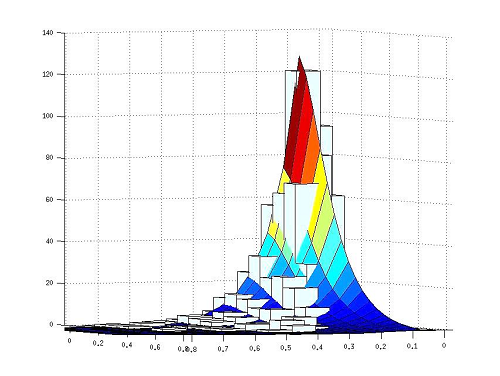 |
Figure 1: Bivariate finite support vector (X, Y), X a normalized G (2, 2) variate over [0, 1], Y = 0.5 X + ϵ, ϵ ̴ exp(1.5), fitted with BFSPH distribution of order 6 .
Virtual element method (VEM) is a newly born baby from Finite element method (FEM) Galerkin approach. In recent years, this method has been extensively studied for a variety of problems such as linear elliptic, parabolic, hyperbolic, stokes problems and so on. We are the first group to work on VEM in India. Our research work mainly focuses on the VEM discretization for the nonlinear equations. The major challenge in devising the computable VEM scheme is due to the fact that the basis functions are not known explicitly. We have formulated and solved a couple of nonlinear problems in this direction. Our most recent work is on the VEM discretization of the nonlinear convection-diffusion-reaction equation. We consider the Streamline upwind Petrov-Galerkin stabilization to reduce the non-physical oscillations present in the solution. We have performed the error analysis by showing the existence of the solution and derived the convergence estimates in the energy norm. Numerical experiments are conducted in order to validate the theoretical results. In this context we have proved an important result which is provided below,
 |
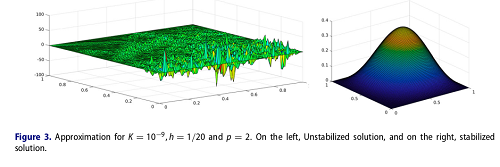 |
The aim of underlying research work is to achieve higher-order uniformly convergent numerical approximation to the solutions of a class of singularly perturbed parabolic partial differential equations (PDEs). These types of model problems can be viewed, for instance, as the unsteady Navier-Stokes equation with large Reynolds number; and generally possess boundary layers. Due to the presence of the layer phenomena, the development of the fitted mesh methods (FMMs), which are uniformly convergent numerical methods constituted on special layer-adapted meshes, plays a key role to achieve accurate numerical results without much resolving the layers, even for smaller values of the perturbation parameter. In this regard, we develop and analyze an efficient fractional-step hybrid FMM for singularly perturbed multi-dimensional parabolic PDEs possessing regular boundary layers, with the emphasis of its theoretical and computational aspects. For approximating the time derivative, we use the Peaceman–Rachford fractional-step implicit method, and for the spatial discretization, a hybrid FMM is proposed on a special rectangular mesh which is tensor-product of piecewise-uniform Shishkin meshes in the spatial directions.
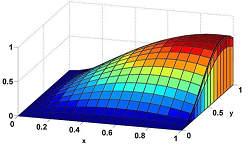 |
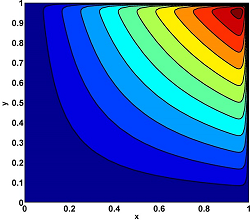 |
Caption: surface plot and contour plot of the numerical solution
The detailed work can be found in the following article:
The mathematical model of fluid flow problems consists of coupled nonlinear partial differential equations, and hence obtaining analytical solutions or even closed-form solutions will be very difficult. Moreover, their numerical simulation in complicated scenarios (such as domains with diverse types of boundary and transmission conditions) remains far from trivial. Therefore, in collaboration with Prof. Ricardo Ruiz-Baier ( Monash University Australia), Prof. David Mora (University of Bio-Bio, Chile) and Prof Raimud Burger (University of Concepcion, Chile), I aim to develop a unified theoretical framework for the mathematical and numerical analysis of non-stationary fluid flow problems, and also other PDE-based models that appear in the coupling of fluid flow and transport problems. In particular, I work on the development (with emphasis on both theoretical and computational aspects) of numerical techniques such as Finite volume element methods, finite element methods, discontinuous Galerkin methods, which are used for obtaining an accurate and robust numerical solution of PDEs occurring in science and engineering with proper initial and boundary conditions. In view of the applicability of virtual element methods (VEMs) with polygonal meshes, VEMs are proven to be very impressive and have attracted the scientific community as far as a numerical approximation of PDEs on polygonal meshes is concerned. Therefore, recently I am focusing on designing suitable virtual element schemes for the approximation of PDEs that are defined on complex domains and polygonal meshes are used in the discretization of the domain. Recently, we have proposed new virtual element formulations for an approximation of nonstationary Stokes, Navier-Stokes, poroelasticity problems and related problems. For instance, the virtual element approximations for velocity and pressure of Lid-driven Cavity problems are shown in the following figure.
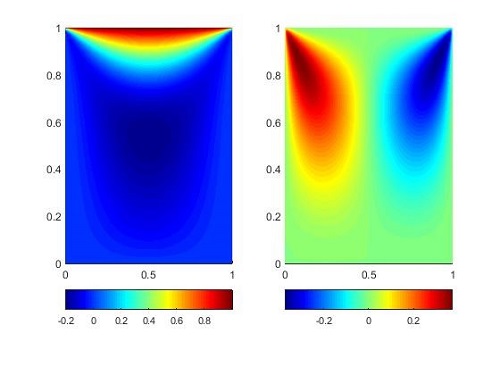 |
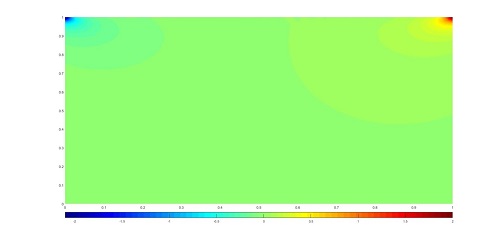 |
These study has been published in reputed international and details are as follows:
A problem in affine algebraic geometry asks the following.
Problem 1. Let R be a ring containing Q, A an A2-fibration over R and D : A → A a fixed point free R-LND. Does D have a slice?
Contributions by Rentschler (1968), Daigle-Freudenburg (1998), Bhatwadekar-Dutta (1997), Berson-van den Essen-Maubach (2001) and van den Essen (2007) established that the above problem has affirmative answer when A is trivial, i.e., A is a polynomial algebra in two variables over R. However, it was not known whether the above result holds when A is a non-trivial A2-fibration over R. In 2016, a partial answer to the problem was given by Kahoui-Ouali showing that the above question has an affirmative answer under the assumption that A is a stably polynomial algebra. But the result of Kahoui-Ouali shows that the hypothesis essentially makes the A2-fibration to be trivial.
In 2021, Babu-Das completely solved Problem 1 when R is Noetherian. Further, the result of Babu-Das completely describes the structure of A2-fibrations over Noetherian rings containing Q having fixed point free locally nilpotent derivations. The main results of the article are the following.
Theorem A: Let R be a Noetherian ring containing Q and A an A2-fibration over R with a fixed point free R-LND D : A → A. Then, Ker(D) is an A1-fibration over R and D has a slice.
Theorem B: Let R be a Noetherian domain containing Q and A an A2-fibration over R having a fixed point free R-LND. Then, A has another irreducible R-LND D : A → A such that Ker(D) is a polynomial algebra in one variable over R and A is an A1-fibration over Ker(D). Further, the following are equivalent.
(I) D is fixed point free.
(II)A is stably polynomial over R.
(III) A is a polynomial algebra in two variables over R .
The graph embedding is the process of representing the graph in a vector space using properties of the graphs. The existing graph embeddings rely mostly on a single property of graphs for data representation which is found to be inappropriate to capture all the characteristics of the data. Hence we designed graph embedding using multi-view approach, where each view is an embedding of the graph using a graph property. The input space of multi-view learning is then taken as the direct sum of the subspaces in which the graph embedding lie. We did analysis on real world data by incorporating the proposed model on support vector machines (SVM). The reproducing kernel used in SVM is represented as the linear combination of the kernels defined on the individual embeddings. The optimization technique used in simple multiple kernel learning (simple MKL) is used to find the parameters of the optimal kernel. In our experimental analysis, the multi-view graph embedding showed a superior performance in comparison with that of the state-of-the-art graph embeddings as well as graph kernels.
The paper was published in:
The onset of turbulence is often related to the randomness of background movement, for instance, structural vibrations, magnetic fields, and other environmental disturbances. One way to model this is to consider randomly forced Navier-Stokes equations. The stochastic forcing that is added to the deterministic Navier-Stokes equation models the influence of the random environment on the fluid in fully developed turbulence. Small noise prevalent in nature is magnified by the instabilities in the flow and therefore, it becomes more useful to consider the velocity in turbulent flow to be a stochastic process. In this context, we considered the Navier-Stokes equations subject random noise which is the sum of Gaussian noise for the continuous process, and Levy noise to model the jump part of the process. We studied the rigorous mathematical justification of the following ergodic principle for the 3D stochastic Navier-Stokes equations which lies at the foundation of the statistical approach to the theory of fluid dynamics: there exists an equilibrium measure over the phase space consisting of velocity fields such that, for every regular observable defined over the phase space, and for every initial velocity field, the time average of the observable tends to the mean value of the observable with respect to the equilibrium measure as time goes to infinity.
Since we are considering the 3D stochastic Navier-Stokes equations with Levy noise, we first construct a Markov family of martingale solutions for this equation. It is then constructively used to obtain the existence of a unique invariant measure, which is ergodic and strongly mixing. Indeed, ergodicity and strongly mixing properties of the invariant measure are obtained from the strong Feller property and irreducibility of the transition semigroup.
The Kerala government launched its ambitious virtual learning programme, with the help of Kerala Infrastructure and Technology for Education (KITE), targeting 4.5 million students in the state from 1 June 2020. The step was both challenging and progressive, considering the digital divide in the state. This study examines the impact of COVID-19 pandemic on the education of Adivasi communities in Kerala. While measures have been taken to ensure digital facilities to the marginalized communities to attend the virtual classes, it is argued that these actions would not yield the desired outcome unless the most basic sociocultural, economic and geographical barriers are addressed. This article is based on an ongoing ethnographic study since February 2018 in Adivasi communities in Kerala.
Ref: K. M. Muhammed Sihas, Lekshmi V. Nair, Impact of COVID-19 on the Education of Adivasi Communities in Kerala, Indian Journal of Human Development (Sage Publications - Published Online Ahead of Print)
https://journals.sagepub.com/doi/abs/10.1177/09737030221099261
Ref: Lekshmi V. Nair, 2021. Education during COVID-19: A Study among Tribal Children in Idukki, Kerala, Social Action, Vol. 71(1) (UGC Care List).
Space programmes all over the globe bring in the scientific, technological, industrial, and security capabilities and have been conceived as important tools used to enhance the socioeconomic development through their use of applications in the civilian domain. In India, the space programme was initiated in the early 1960s with the main objective of using these same capabilities for rapid economic development of the country and these investments are particularly justified based on their socioeconomic returns for larger sections of the society through increased economic activity, cost efficiencies, productivity gains, and inclusiveness to different sectors of the economy. Reaping the demographic advantage of India requires the optimum use of existing resources by using advanced space technologies, which have extensive forward and backward relationships in the economy. Space technology provides the vital applications in several sectors, such as communications, meteorology, natural resource planning, inputs for weather forecasting, and disaster management. The forward connections of space technology help to create innovation, expand knowledge, enhance information given to decision makers, improve governance, generate spin-offs, etc. It stimulates economic activity related to space products and services from satellites, launch vehicles, ground systems, etc. Indirect benefits resulting from space technology over time include improved economic prosperity, health, environmental quality, safety, and security; creation of new capabilities, businesses, products and services derived from space-based applications; enhanced productivity of various sectors; and enriched quality of life in society. The majority of these contributions are multifaceted in nature, intangible in property, and incommensurable in scale. Considering all of these factors, the Department of Space (DoS) decided around 2005 to have the economics of the space programme examined by an expert in the field. Accordingly, this task was entrusted to well-known economic expert Prof U. Sankar from the Madras Institute of Economics. This chapter essentially describes the necessity of economic analysis of the Indian space programme in the light of the study of The Economics of India’s Space Programme, by U. Sankar.
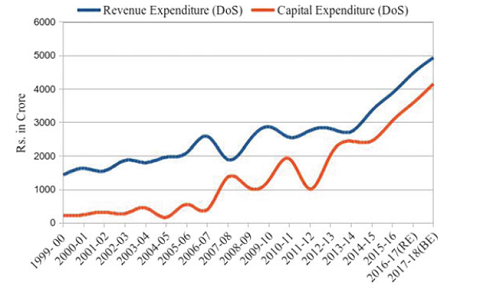 |
Ref: Kasturirangan, K., Shaijumon, C.S. (2021). Economics and Cost Benefit Analysis of Indian Space Programme. In: Suresh, B.N. (eds) Space and Beyond. Springer, Singapore. https://doi.org/10.1007/978-981-33-6510-0_14
This study is the first attempt at understanding the size and structure of the space economy of the country using an internationally accepted but eclectic framework developed by the OECD and the UK Space Agency. Employing the framework, it is estimated that space economy contributes around 0.23 per cent, on average, of the country’s GDP. The study highlights that the size is susceptible to the size of the space budget, growing directly with it. Our exercise has decomposed the space economy into its three segments or components: space manufacturing, space operations, and space applications. Of the three space applications is, the largest one is space applications accounting for about 74 per cent, followed by space operations, about 22 per cent and finally space manufacturing, about 4 per cent. This structure is very consistent with the space economies of other countries such as the UK. Within the dominant segment of space applications, there are three major industries, namely space telecommunications, Direct to Home (DTH) Satellite TV network and space-based earth observation. Of the three, space telecommunications and space-based earth observation subsectors are bound to grow manifold in the foreseeable future, given supportive public policies and the likely surge in demand for location services. This study reinforces global trends of the space economy. First, there is a worldwide attempt to delineate the contours of this intensive high-technology industry. Even in the West, statistical agencies are still proceeding on an iterative basis to estimate its size. There is no real consensus on what constitutes a spacefaring nation’s space economy. This is because the space economy spans both manufacturing and services, and in several industries, space technology enters along with other technologies. So separating space technology from other technologies used is fraught with practical difficulties. The case of the telecommunications services industry is a case in point. Second, government budgets play an essential role in creating and nurturing the space industry. Although there aren’t any econometric exercises, it is generally accepted that public investments in space technology crowd in private sector investments. Third, space manufacturing and launching technology have evolved so much that even small and medium enterprises can enter this industry that has been the exclusive preserve of large public sector entities such as NASA or ISRO. Fourth, a combined effect of especially the latter two issues has led to large scale entry of private sector enterprises into the space economy, that has been facilitated in India by recent policy shifts. While this study has put a number on the size and constituents of the space economy, the next logical step is to analyse the impact of the space economy on the rest of the economy. While the preceding exercise captures the direct impacts, this new proposed study will have to capture the indirect impacts.
Ref: Mani, Sunil, V K Dadhwal and C S Shaijumon (2022), The Space Economy of India: Its size and structure, Space Policy, (In Press)
Access, equity, affordability, and cost effectiveness are the watchwords of Indian healthcare system. Telemedicine in India is still in its stage of infancy but the impact of Covid 19 pandemic increased the acceptance, demand, and expansion of the Telemedicine technology. In the wake of Covid 19 Pandemic the entire health care system of India is undergoing changes and the need of Telemedicine is significant in this scenario. Telemedicine is not a new concept introduced in Indian healthcare system during Covid19 pandemic, but in the initial period it is limited in the specialized areas of healthcare as well as certain hospitals in the country. The study found that the remote and marginalized rural sections of Indian population began to use the benefits of Telemedicine during the pandemic, and it got diversified in different fields. The socio-economic impacts of telemedicine technology is very promising and the full-fledged expansion through the access of services will take more time. Even though telemedicine is not an alternative to direct interaction with physicians, the system is very helpful for reaching the unreached.
Ref: Shaijumon C S, Lekshmi V Nair (2022), Socio-economic impacts of telemedicine during Covid 19 period, Space Policy (in Press).
India has the largest dairy industry in the world and accounts for a significant share of the global emission of livestock methane (CH4), a potent greenhouse gas (GHG). While previous works have examined the large-scale livestock CH4 emissions in India, bottom-up studies are essential to account for the diverse farm conditions and practices across the subcontinent. We developed a Methane Calculator for Indian livestock sector using the Intergovernmental Panel on Climate Change (IPCC) Tier 2 methodology for estimating methane emissions from enteric fermentation and manure management. Using this calculator, we undertook a study of emissions from four dairy farms in the tropical coastal district of Thiruvananthapuram, Kerala, in June 2019. Livestock population and milk production data were collected from the four farms, to compute a mean CH4 emission of 0.7183 kg CO2 equivalents/kg of fat and protein corrected milk (kg CO2e/kg FPCM), with a notable farmto-farm variability (63.3%). Having implemented the latest available guidelines outlined by the IPCC, our results are a valuable new addition to the existing body of knowledge in the measurement of dairy farm GHG emissions. We present this as a pilot study, demonstrating a simple method to perform bottom-up investigations of dairy GHG emissions and further formulate policy interventions and mitigation strategies at the farm level
Ref: Pradeep, G., Shaijumon, C.S., Rajkumar, R. et al. Methane emissions from dairy farms: case study from a coastal district in South India. Environ Dev Sustain (2022). https://doi.org/10.1007/s10668-021-01851-w
This is mainly concerned with the cultural mapping of cuisines of the tribal/ Adivasi communities of Kerala. A cultural mapping to understand the culinary habits of the native tribal population will help in sensitizing the people regarding the necessity to preserve and cultivate the natural and ethnic products, which will ultimately help in guaranteeing food sufficiency. In the post-pandemic world, where people are more concerned with health and lifestyle diseases, embracing one’s roots through the culinary will help in guaranteeing a healthy generation. As a pilot study, a study has been conducted among the Kani tribes in Vithura, and a documentary has also been made on the tribal culinary expert Chandrika Vaidya
Ref: Gigy J Alex, "Cookbooks from Keralam: Creative Adaptations and Inscriptions of Alternative Modernities", Malayalam Research Journal. Vol. 14 Issue 3 September-December 2021
The concept of eco-efficiency is an important step in the move towards sustainable development. In the present day business, organizations have to take care of both the economic growth and environmental impact. Eco-efficiency determines the value of a product considering its environmental impact. In this research, the eco-efficiency requirements of an electronics industry are analyzed. The Customer requirements (CRs) and Design requirements (DRs) are identified for increasing the eco-efficiency in the industry. Seven CRs and fourteen DRs are identified for the electronics industry to improve eco-efficiency. An integrated Analytical Network Process (ANP) and Quality Function Deployment (QFD) is applied to prioritize the design requirements as per the customer's needs. QFD helps to incorporate the concept of the voice of customers for the design and development of products/services. The House of Quality developed translates the CRs to prioritize the DRs to improve eco-efficiency. The study encompasses the voice of customers in developing the sustainability performance of the electronics supply chain. It is found that design requirements to reduce greenhouse gases, air emissions, volatile organic compounds and carbon footprint is the most significant design parameter for eco-efficiency. The next design requirements with higher importance are Reduced use/consumption of resources, Use renewable energy like solar, State of the art innovative materials, Technologies for reducing use/consumption of energy, Green suppliers, green procurement, and Design for Environment. Focusing on these DRs aid in achieving the eco-efficiency goals of an organization. The paper
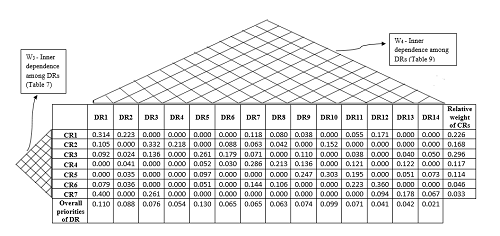 |
contributes to the environmental sustainability aspect by identifying, prioritizing and creating a framework of requirements for eco-efficiency gains by an organization. The limitations and future scope of the study are also discussed.
Ref: Menon, R.R. and Ravi, V., 2021. Using ANP and QFD methodologies to analyze eco-efficiency requirements in an electronic supply chain. Cleaner Engineering and Technology, 5, p.10035; https://doi.org/10.1016/j.clet.2021.100350.
Digital twin and physical internet adoption based on advanced digital technologies is gaining significance in the recent times. Digital twin is one of the enabling technologies that link actual physical system with its virtual depiction using advanced digital technologies. In order to leverage its potential, firms have instigated to adopt digital twin and physical internet for real-world applications. Although researches on impact of information technology in supply chains exists, a study on the modelling aspects by analysing critical success factors for adoption of digital twin and physical internet is limited. We have addressed this gap by developing a structural model for identifying the inter-relationships and cause effect parameters of critical success factors for adoption of digital twin and physical internet. Thirteen critical success factors were shortlisted based on literature review and in consultation with experts. An integrated Grey- based, decision making trial and evaluation laboratory (DEMATEL)is used to visualize the causal relationships among critical success factors and verified by applying the proposed model in an electronics manufacturing firm. Sensitivity analysis has been done to check accuracy of results and robustness of the study. The results reveal that top management commitment and support and long, medium and short term planning are the most influential factors impacting the adoption of digital twin and physical internet in electronics industry. Findings of this research provide insights for supply chain managers and academicians by identifying the cause and effect group critical success factors for effective adoption of digital twin and physical internet.
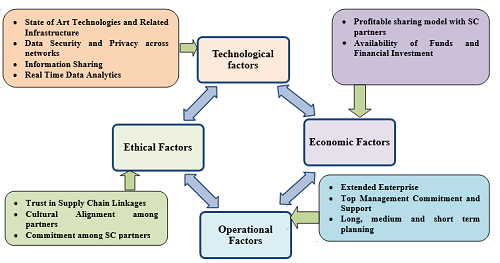 |
Ref: Deepu, T.S. and Ravi, V., 2021. Exploring critical success factors influencing adoption of digital twin and physical internet in electronics industry using grey-DEMATEL approach. Digital Business, 1(2), p.100009; http://dx.doi.org/10.1016/j.digbus.2021.100009
A robust and dynamic supply chain can be developed using advanced digital technologies, enabling real-time information sharing. This study provides a conceptual framework for effective supply chain digitalization by considering the key decision-making factors and interrelationships. The key decision-making factors affecting the digitalization process are identified from the literature and consultation with industry and academia experts. A conceptual framework is developed using the integrated systems model approach and DIKW (Data, Information, Knowledge, and Wisdom) hierarchy. Further, an integrated decision support system is also developed for effective decision-making on digitalization. The factors identified were also classified under three major dimensions like organizational, technological, and innovative dimensions for effective management. The findings of the study were validated based on feedback from experts and a comparison with existing literature. The study contributes to the knowledge of supply chain digitalization by introducing a novel method and approach. The sequential methodology and the
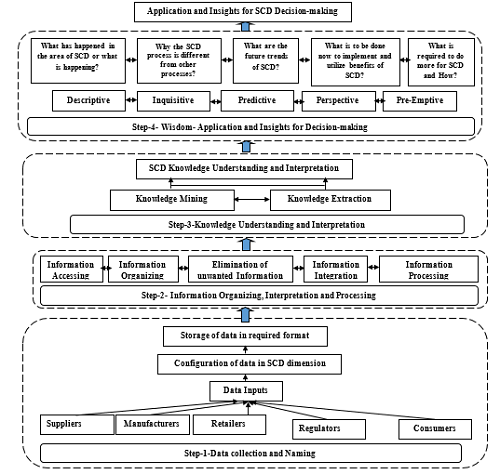 |
framework developed can support the decision-making process and development of appropriate design for digitalization.
Ref: Deepu, T.S. and Ravi, V., 2021. A conceptual framework for supply chain digitalization using integrated systems model approach and DIKW hierarchy. Intelligent Systems with Applications, 10, p.200048; https://doi.org/10.1016/j.iswa.2021.200048
The systematic study of the EM wave propagation in ON to ON-Body using the twelve-cylinder phantom model which aids in static as well as dynamic system modelling is investigated using systematic simulation and experimental measurements in advancement microwave research Lab at the department of Avionics by Elizabeth George and Dr. Chinmoy Saha.
The twelve-cylinder phantom model (Link) is a simplified human body model featuring the critical parts of human body segments such as head, shoulder, torso, upper arm, lower arm, thighs and calf. For the study of ON-to ON-Body transmission characteristics two cross slot antennas having omnidirectional radiation pattern are used. An in-depth investigation of creeping waves and double arm swing activity using the twelve-cylinder model under different configurations and dynamic situations are executed with transmission characteristics. The investigation of creeping wave characteristics is performed using a simplified cylindrical phantom model. The propagation of electromagnetic waves on the body includes a union of free space propagation, creeping waves which is due to the diffractions as well as the reflections from the environment. The work deals with the propagation of creeping waves around a lossy dielectric cylinder in a circular fashion to mimic EM analysis in body worn antenna environment. The study of creeping waves around the torso will provide more insights on ON-Body to ON-Body propagation. This is followed by introduction of a human model which features the critical body for the study of double arm swing activity. Two cross-slot antennas (CSA) are designed and fabricated, for investigation of creeping waves along with the double arm swing activity using the newly introduced twelve-cylinder body model. The study of double arm swing activity is performed by considering different dynamic positions of the phantom model, keeping #Ant1 on the chest and #Ant2 on the lower arm. The use of twelve-cylinder body model significantly reduces the experimental procedures as well as research cost. The work also investigates the effect of varying orientation of antenna on a four-year child model.
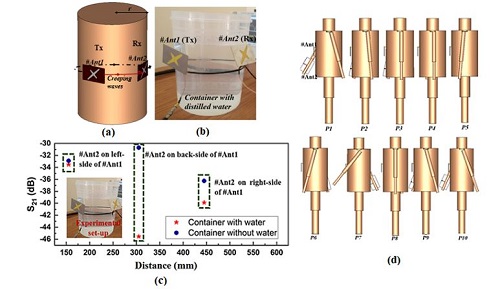 |
Fig. (a) Creeping wave simulation set-up using CSA on phantom model, (b) Experimental set-up using container with distilled water, (c) Experimental study using CSA and a container with and without distilled water at 2.4 GHz and (d) Frames P1-P10 illustrating the double arm swing activity.
Ref: Elizabeth George and Chinmoy Saha, “Investigation of Creeping Wave Characteristics and Double Arm Swing Activity using Twelve Cylinder Phantom Model” IEEE Antennas and Wireless Propagation Letters, Vol.21, No.10, PP.2090-2094, July 2022.
Ref: Elizabeth George, Chinmoy Saha, Investigation of on-Body Creeping Wave Mechanism and Double-Arm Swing Activity forWBAN Applications, IEEE MTTS-International Microwave and RF Conference (IMaRC 2021), December 17-19, 2021, IIT Kanpur, India (Third Prize-Female Student Paper award).
High frequency link bidirectional converters are characterized by a high frequency inductor current. Superior dynamic performance and saturation prevention requires sensing of this high frequency current and high bandwidth ADCs for subsequent signal processing. Typically Hall effect based sensors, having their own reasonable footprints and volume, are directly mounted on the power bus bar. This makes the realization of a highly compact bus bar structure more difficult. A sensorless current envelope tracking based scheme has been proposed which also do not require any high bandwidth ADCs. The ingenuity of the proposed scheme lies in estimating the envelope of the fundamental component of the current and subsequently controlling it. This scheme also leads to direct estimation of the peak current envelope, which can be easily integrated with the overall control scheme for overcurrent protection and saturation prevention. Hence, a control scheme is arrived at which is equally effective as erstwhile techniques and at the same time comes with much lesser computational overhead. The proposed control scheme is validated through a laboratory prototype. One of the key experimental results are shown in Figure 1.
 |
Fig. 1. Experimental results for peak envelope estimation. Top trace: estimated ipke envelope (1 V/div). Second trace: actual iLs (10 A/div) (a and b), (5 A/div) (c). Third trace: vo (50 V/div). Bottom trace of (a) and (b): io (2 A/div). Bottom trace of (c): vdc (50 /div). (a) and (b) Time 20 ms/div. (c) Time 1 s/div. (a) 50% step increase in load current. (b) 50% step decrease in load current. (c) 15% ramp variation in input voltage.
Ref: G. Nayak and A. Dasgupta, "Inductor Current Envelope Tracking-Based Sensorless Control of Dual Active Bridge Converter," in IEEE Transactions on Power Electronics, vol. 37, no. 7, pp. 7907-7915, July 2022, doi: 10.1109/TPEL.2022.3151503.
Generally, controllers are tuned to meet the desired time and frequency domain specifications for integer/fractional order real coefficient systems whose frequency response is symmetric about the origin of the complex frequency plane. These controllers are tuned through analytical/numerical approaches. On the contrary, the frequency responses of the complex coefficient systems are unsymmetrical, and hence tuning of controllers should consider both positive and negative frequencies. In this article, tuning of complex coefficient proportional integral derivative controller is proposed for such systems to meet the desired frequency domain specifications in positive and negative frequencies. For illustration, the simulation results are presented for stable, unstable, and non-minimal phase systems with the proposed tuning method.
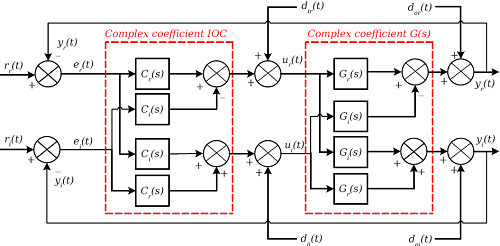 |
Fig.1 CCTF representation in closed loop
Ref: P.Sathishkumar, N.Selvaganesan, "Tuning of Complex Coefficient PI/PD/PID Controllers for a Universal Plant Structure", International Journal of Control, Vol.94, Issue 11, PP.3190-3212, 2021.
Ref: M.Rohith Bala, P.Sathishkumar, N.Selvaganesan, "Unified complex coefficient PID controller tuning for complex coefficient system", IETE Journal of Education, 2021 (Accepted)
In the tracking-by-detection approach of online multiple object tracking (MOT), a major challenge is how to associate object detections on the new video frame with previously tracked objects. Two important aspects that directly influence the performance of MOT are quality of detection and accuracy in data association. The authors propose an efficient and unified MOT framework for improved object detection, followed by enhanced object tracking. The object detection and tracking are considered as two independent functions in the tracking-by-detection paradigm. In this study, object detection accuracy has been increased by employing a faster region-based convolutional neural network (Faster R-CNN) modified with the feedback region proposals from the tracker. Target association is performed by the correlation filter-based Siamese CNN model, which finds the similarity score between the input image patches. The Siamese CNN is trained using a supervised hard sample mining strategy. An optical flow-based motion model is employed to predict the next probable location of the targets from the tracker and these region proposals are fed back to the classifier module of Faster R-CNN. The authors’ extensive analysis of publicly available MOT benchmark datasets and comparison with the state-of-the-art tracking methods demonstrate competitive tracking performance of the proposed MOT framework.
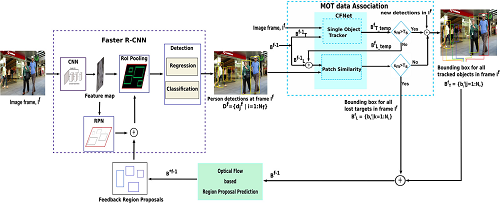 |
Ref: Prasanna Kumar, A. and Mishra, D. (2020), Harnessing feedback region proposals for multi-object tracking. IET Comput. Vis., 14: 434-442. https://doi.org/10.1049/iet-cvi.2019.0943
The introduction of new wireless services and the quest for high-speed communication with enhanced data rate and channel capacity have led to unprecedented congestion in the RF spectrum. A cognitive radio (CR) system provides a sustainable solution due to its opportunistic and intelligent usage of the spectrum using ‘dynamic’ spectrum policy. In a CR system, the spectrum is shared using the sub-bands in an ultrawideband (UWB) frequency range. The available spectrum over an UWB spectrum which includes/excludes the frequency band of the primary users, known as ‘white space’, is scanned to detect the unused/idle band which is then dynamically allotted to the secondary users for ‘communication’. This dynamic allocation of sub-bands through frequency scanning and subsequent communication, requires an intelligent multifunctional antenna system. More specifically, an UWB antenna (known as sensing antenna) is used to detect the ‘white space’ and a narrow-band antenna is required for ‘communication’.
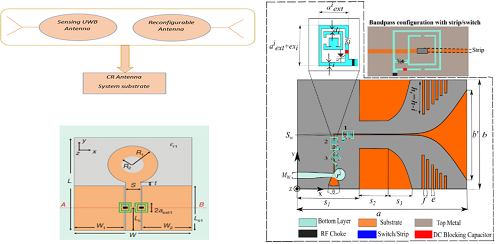 |
Caption: Conceptual block diagram and various types of CR Antennas
Dr. Saha’s research group in the department of Avionics has contributed in design and development of new types and class of antennas for CR applications [1]-[3]. The group has shown that by improvised designing of the UWB antennas and loading of various switching and tuning elements, such as, PIN diodes, varactor diodes etc. multfuncional antennas with dual tunable features can be realized. The concept has been established with precise computation of the resontaors & radiators and have been established for various genres of UWB radiator, such as circular monopole antenna, its variants and tapered slot antennas.
Ref: C. Saha, J. Y. Siddiqui and Y.M.M. Antar, “Mulltifunctional Ultrawideband Antennas: Trends, Techniques and Applications”, Taylor and Francis, 6000 Broken Sound Parkway , NW, Suite 300, Boca Raton, Florida 33487, USA (April 2019, ISBN: 9781138553545).
Ref: S. Keerthipriya, C.Saha, D. Sarkar, JY Siddiqui, and Y.M.M. Antar, “ Varactor Controlled SRR Integrated Frequency Reconfigurable Multifunctional Antenna”, IEEE Antennas and Propagation Magazine, July 2021 ( Early Access). doi: 10.1109/MAP.2021.3106893.
Ref: L.Ahmed, C. Saha, Y.M.M. Antar, and J.Y. Siddiqui, “ An antenna advance for Cognitive Radio: Introducing Multilayered Split Ring Resonator Loaded Printed Ultra-Wideband Antenna with Multi-Functional Characteristics” IEEE Antennas and Propagation Magazine, Vol. 60, issue. 2, pp 20-33, March 2018.
Dr. Chinmoy Saha’s research contribution encompasses key areas of applied Electromagnetics in general and state of the art techniques and methodologies in the area of i) microwave and mm wave circuits and antennas, ii) multi-functional antennas for modern wireless applications, iii) metamaterial inspired circuit and antennas, iv) wireless power transfer and energy harvesting and v) optical fiber based sensors, in particular. One of the key contributions, evolved from an effective collaboration between his research group and National Remote Sensing Centre, Hyderabad is the design, fabrication and realization new set of feed antennas for satellite tracking applications. As shown in the block diagram and the fabricated antenna prototype in Fig. , the proposed X-band tracking antenna system consists of one large-aperture corrugated horn acting as main element to extract the communication (sum port) signal and four side-launched circular waveguide elements around the central corrugated horn acting as tracking elements by extracting error signals in both azimuth and elevation [1]. The realized dual polarized compact antenna acts as feed for a 4.5 m Cassegrain ground-station reflector antenna and currently operational for efficient communication and tracking of Low Earth Orbit (LEO) satellites.
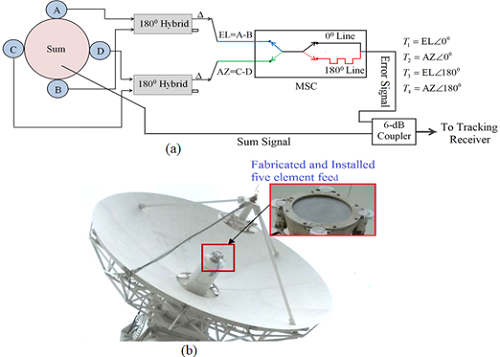 |
Caption: X-band Feed Antenna System for Satellite Tracking Applications: (a) over-all block diagram and (b) realized antenna prototype currently in operation
Ref: S. S. Roy, C. Saha, S.B. Mane, T. Nagasekhar, , M Naresh Kumar, C S Padmavathy and G. Umadevi, “Design of a Compact Multi-Element Monopulse Feed for Ground Station Satellite Tracking Applications ”IEEE Antennas and Wireless Propag. Lett. Vol. 8, pp. 1721-1725, 2019.
In the research paper authored by Mohit Singh et al. in 2024, published in the Journal of Aerosol Science and Technology (AST), the estimation of the mass absorption cross-section (MAC) of black carbon was conducted. This estimation was achieved through simultaneous measurements of black carbon utilizing filter-based instruments, namely a characterized continuous soot monitoring system (COSMOS) and Aethalometer. The study was carried out at four distinct sites: Alert, Barrow, Ny-Ålesund, and Pallas, all situated in the Arctic region.
The findings revealed that the derived MAC of black carbon displayed minimal spatial and temporal variations. Notably, the study observed a remarkable consistency in the MAC of black carbon among different filter-based light absorption photometers at various sites in both the mid-latitudes and the Arctic, with the differences being within 10%. This observation is particularly noteworthy given the distinct aerosol characteristics prevalent in these two regions. Importantly, this finding represents a significant contribution to the scientific understanding of black carbon's behavior and its implications across different geographical locations, marking the first report of its kind.
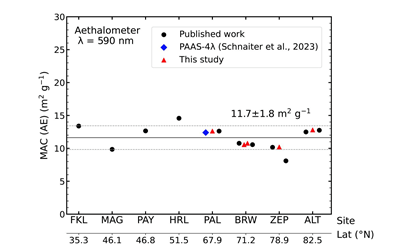 |
Mass absorption cross-section (MAC) values of black for Aethalometer MAC(AE) at mid-latitude, and Arctic sites.
Reference
Mass absorption cross section of black carbon for Aethalometer in the Arctic
Mohit Singh, Yutaka Kondo, Sho Ohata, Tatsuhiro Mori, Naga Oshima, Antti Hyvärinen, John Backman, Eija Asmi, Henri Servomaa, Franz Martin Schnaiter, Elisabeth Andrews, Sangeeta Sharma, Kostas Eleftheriadis, Stergios Vratolis, Yongjing Zhao, Makoto Koike, Nobuhiro Moteki & P. R. Sinha, 2024: Mass absorption cross section of black carbon for Aethalometer in the Arctic, Aerosol Science and Technology, DOI: 10.1080/02786826.2024.2316173. https://doi.org/10.1080/02786826.2024.2316173
Aerosols distributed in the troposphere can scatter and absorb solar radiation and modify the Earth's radiation budget and cloud properties. The combined effect of scattering and absorption by particles is defined as aerosol extinction coefficient, is a measure of the alteration of radiant energy as it passes through the atmosphere. The aerosol extinction coefficient was derived with the space-borne lidar Cloud-Aerosol Lidar with Orthogonal Polarization (CALIOP) aboard the Cloud-Aerosol Lidar and Infrared Pathfinder Satellite Observations (CALIPSO) over the Indian region during 2008–2018. The vertical profiles of aerosol extinction coefficient depicted persistent layers between 4 and 6 km over the Indian region named elevated aerosol layers (EALs). In the summer and fall seasons, the thickness of the EALs increased by 36.7% and 25% from the annual mean, respectively. Throughout the year, dust and polluted dust aerosols accounted for up to 50%–80% of the EALs composition between near-surface and 6 km. Stratified EALs between 4 and 6 km were formed by locally confined wind recirculation coupled with stable atmospheric layers during the winter, spring, and fall seasons. In summer, the vertical transport of pollutants from the planetary boundary layer to the mid-troposphere associated with enhanced deep convection played a crucial role in the formation of EALs
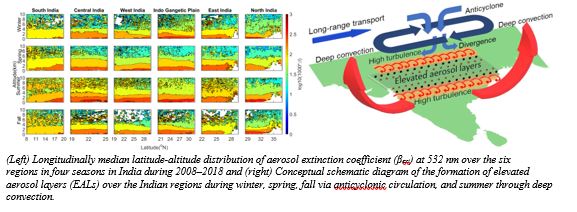 |
Reference:Kumar, G., Madhavan, B. L., Sahu, L. K., Kumar, Y. B., Vernier, J.-P.,Liu, H., et al. (2023). Multi-year CALIPSO observations of ubiquitous elevated aerosol layer in the free troposphere over South Asia: Sources and formation mechanism. Journal of Geophysical Research: Atmospheres, 128, e2021JD036277. https://doi.org/10.1029/2021JD036277
Measurement of particulate matter (PM) such as black carbon (BC) aerosols over urban sites is critically important owing to its adverse health and climate impacts. However, the impacts associated with BC are poorly understood primarily because of the scarcity and uncertainties of measurements of BC. Here, we present BC measurement at an urban site of Delhi using a characterized continuous soot monitoring system (COSMOS) for a year-long period, i.e., from September, 2019 to August, 2020 as part of research collaboration between University of Tokyo, National Institute of Polar Research (NIPR) Japan, Indian Institute of Space Science and Technology (IIST) and National Physical Laboratory (NPL), India.This measurement period covers events, i.e., period of crop residue burnings from nearby states, festive events, e.g., Diwali and New Year, and first COVID-19 lockdown period. Effects of these events combining with local emissions and meteorological conditions on BC mass concentration (MBC) are investigated to find the possible cause of severe pollution levels in Delhi. Winter season (December to February) is observed to be the most polluted season owing to increased local emissions and non-favorable meteorological conditions. Regional emission from crop burning in nearby states during October and November is the main contributing factor for increased pollution in this postmonsoon season. Significant decrease in MBC due to COVID-19 lockdown is also observed. MBC in summer and monsoon are lower as compared to other seasons but are still higher than mean MBC levels in several other urban cities of different countries.
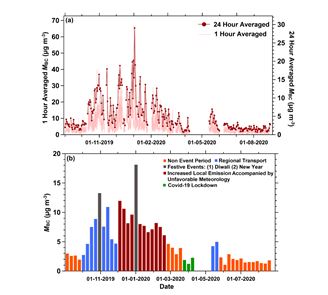 |
Temporal variation of BC mass co ncentrationsC: (a) 1-hour, 24-hour, and (b) weekly averaged.
Proper mitigation steps should be taken to control high level of pollution especially in postmonsoon and winter seasons. These could be control over biomass burning (crop burning) in nearby states during October and November and controlling local emission sources (open burning to fight cold, vehicular emission) in winters. Several initiatives have been taken to control crop residual burning in nearby states. New agricultural machinery like happy seeder and super straw management system are promising innovations which can potentially alleviate the crop-residue burning issue. However, not much focus has been given to control local emission sources in winters. Furthermore, implementation of ban on crackers is required to control emissions during festivals like Diwali and New Year. More rigorous study primarily focused on quantification of local emission source contribution to overall BC pollution (traffic, local open burning in winters and cracker burning) in Delhi is the needed.
Reference:Arpit Malik, Shankar G. Aggarwal, Sho Ohata, Tatsuhiro Mori, Yutaka Kondo, P. R. Sinha, Prashant Patel, Baban Kumar, Khem Singh, Daya Soni, Makoto Koike (2022), Measurement of Black Carbon in Delhi: Evidences of Regional Transport, Meteorology and Local Sources for Pollution Episodes, Aerosol and Air Quality Research (AAQR), https://doi.org/10.4209/aaqr.220128.
Massive stars (M ≳ 8 Msun) play an important role in the evolution of the interstellar medium due to their high energy output, supernovae explosions, and enrichment of the surrounding medium by heavy elements. The formation of these stars can be studied through the HII regions formed due to the increased output of UV photons from them. Moreover, a multiwavelength study of the molecular clouds associated with these HII regions gives important clues about the evolutionary stages of star-formation. We have studied the southern HII region RCW 42 and its associated molecular cloud at radio, near, mid, far infrared and millimeter wavelengths to estimate its properties (column density, temperature, electron density, ionization fraction, bolometric luminosity) and study the evolutionary stages of various clumps present in the region. The HII region has been investigated by studying the ionized gas emission, emission from cold and warm dust and identifying its ionizing candidates. An extended green object EGO G274.0649-01.1460 has also been identified in the region. We have constructed column density and temperature maps and have identified five dust clumps from the former. We have also identified two mm emission cores towards the radio emission peak. All the five dust clumps are found to be in the active/evolved phase based on various star-formation tracers.
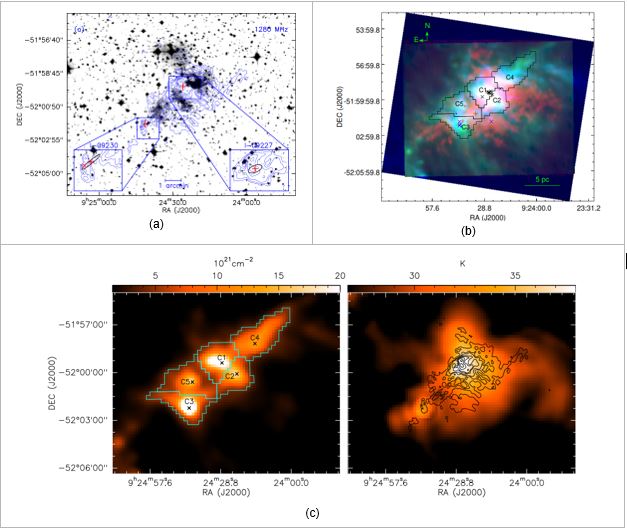 |
Caption: (a) Optical and radio continuum emission contours towards RCW 42 (b) Color-composite image of RCW 42 depicting the ionized gas emission at 1280 MHz (red), cold dust emission at 250 µm (green) and mid-infrared emission at 8 µm (blue). Ionizing candidates are shown as x and + signs. (c) . Maps of column density overlaid with clump apertures (left), and (b) dust temperature overlaid with contours of radio emission (right)
Reference: Investigating star-formation activity towards the southern HII region RCW 42, Vipin Kumar, Sarita Vig, V.S. Veena, Sreelakshmi Mohan, S.K. Ghosh, Anandmayee Tej and D.K. Ojha, 2022, Monthly Notices of the Royal Astronomical Society, Volume 515, Issue 4, October 2022, Pages 5730–5742, https://doi.org/10.1093/mnras/stac2124
Globular clusters are known to serve as fundamental test beds for stellar evolution theories. NGC 5053, a metal-poor and a rather dispersed globular cluster, was studied in the ultraviolet regime with AstroSat's Ultra Violet Imaging Telescope (UVIT). The images of the cluster were analyzed in various filters across the FUV and NUV bands by a team led by IIST researchers. The team discovered eight blue straggler candidates, six evolved blue straggler candidates, and an extreme horizontal branch candidate among the cluster's new probable UV bright population. Using GAIA EDR3 data, a proper motion analysis was used to validate their association with the cluster, and spectral energy distribution (SED) studies were used to corroborate the nature of these candidates. Furthermore, the radial distribution analysis of the blue straggler population shed some light on the potential formation mechanism of these stars in NGC 5053
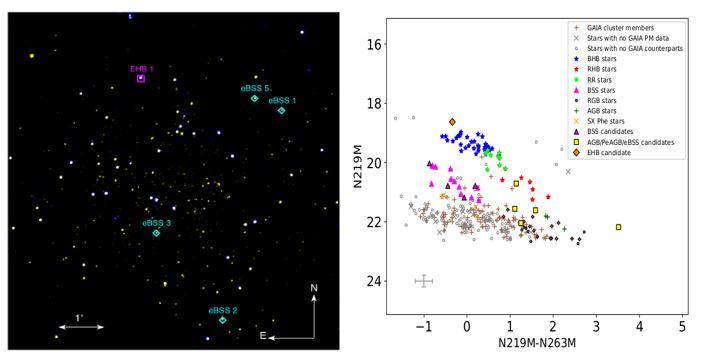 |
Caption: (Left) UVIT-AstroSat image of the globular cluster NGC 5050 with the far-ultraviolet emission displayed in blue and near-ultraviolet emission in yellow. The image also shows the location of a few discovered candidates of the cluster. (Right) The UVIT color-magnitude diagram showing the cluster's various populations.
Ref: Stellar populations of the globular cluster NGC 5053 investigated using AstroSat - Ultra Violet Imaging Telescope, K. J. Nikitha, S. Vig and S. K. Ghosh, 2022, Monthly Notices of Royal Astronomical Society (MNRAS), Volume 514, Issue 4, August 2022, Pages 5570–5582, https://doi.org/10.1093/mnras/stac1444 .
Measurement of particulate matter (PM) constituent such as black carbon (BC) over urban sites is critically important owing to its adverse health and climate impacts. However, the impacts associated with BC are poorly understood primarily because of the scarcity and uncertainties of measurements of BC. Here, we present BC measurement at an urban site of Delhi using a characterized continuous soot monitoring system (COSMOS) for a year-long period, i.e., from September, 2019 to August, 2020. This measurement period covers events, i.e., period of crop residue burnings from nearby states, festive events, e.g., Diwali and New Year, and first COVID-19 lockdown period. Effects of these events combining with local emissions and meteorological conditions on BC mass concentration (MBC) are investigated to find the possible cause of severe pollution levels in Delhi. Winter season (December to February) is observed to be the most polluted season owing to increased local emissions and non-favorable meteorological conditions. Regional emission from crop burning in nearby states during October and November is the main contributing factor for increased pollution in this postmonsoon season. Significant decrease in MBC due to COVID-19 lockdown is also observed. MBC in summer and monsoon are lower as compared to other seasons but are still higher than mean MBC levels in several other urban cities of different countries.
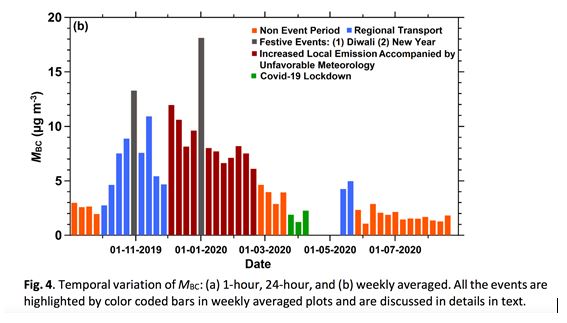 |
Proper mitigation steps should be taken to control high level of pollution especially in postmonsoon and winter seasons. These could be control over biomass burning (crop burning) in nearby states during October and November and controlling local emission sources (open burning to fight cold, vehicular emission) in winters. Several initiatives have been taken to control crop residual burning in nearby states. New agricultural machinery like happy seeder and super straw management system are promising innovations which can potentially alleviate the crop-residue burning issue. However, not much focus has been given to control local emission sources in winters. Furthermore, implementation of ban on crackers is required to control emissions during festivals like Diwali and New Year. More rigorous study primarily focused on quantification of local emission source contribution to overall BC pollution (traffic, local open burning in winters and cracker burning) in Delhi is the need of the hour.
Ref :Arpit Malik, Shankar G. Aggarwal, Sho Ohata, Tatsuhiro Mori, Yutaka Kondo, P. R. Sinha, Prashant Patel, Baban Kumar, Khem Singh, Daya Soni, Makoto Koike (2022), Measurement of Black Carbon in Delhi: Evidences of Regional Transport, Meteorology and Local Sources for Pollution Episodes, Aerosol and Air Quality Research (AAQR), https://doi.org/10.4209/aaqr.220128.
Protostellar jets serve as the principal signature of ongoing star formation activity. Observations have revealed that the radio emission from protostellar jets arise from a combination of thermal free-free and non-thermal synchrotron emission mechanisms. The observed radio spectra of protostellar jets can be explained with the help of emission models and we have developed, for the first time, a simplistic numerical model that is applicable for narrow as well as wide-angle protostellar jets, and could explain the signatures of synchrotron emission in their radio spectra. In addition, we introduce a lateral variation in the ionization fraction within the jet such that the jet is highly ionized along its axis and the ionization fraction decreases as a power-law with distance from the axis. The model geometry is such that the highly ionized regions close to the jet axis contribute to the majority of free-free emission and the outer edges that impact on the ambient medium result in the formation of astrophysical shocks where the conditions are suitable for the generation of synchrotron radiation along with free-free emission. We have studied the influence of each parameter on the characteristics of the model spectra and this enables us in estimating the parameters associated with the jets for which non-thermal emission was detected. The figure shown below represents the model jet geometry and illustrates the variation in flux densities across the length of the protostellar jet.
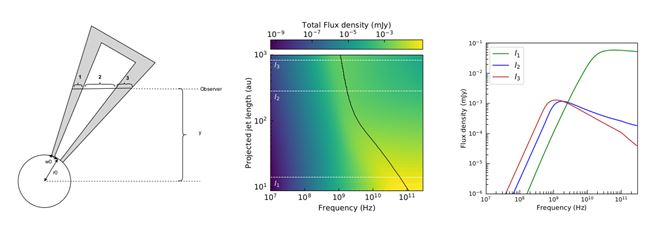 |
Caption: [Left] Schematic diagram of the jet representing the different layers of particle distribution along a specific line-of-sight at an arbitrary jet length projected on the sky plane (y). Regions 1 and 3 give rise to a combination of thermal and non-thermal emission, while Region 2 solely contributes to thermal emission. [Center] The flux density distribution (combined free-free and synchrotron) as a function of frequency (ν) and projected length (y) plotted in logarithmic space. The black curve represents the variation of the turnover frequency where emission is maximum. l1, l2 and l2 marked in white are three different positions along y, whose spectra are shown in [right].
Ref: Radio spectra of protostellar jets: Thermal and non-thermal emission, Sreelekshmi Mohan, S. Vig, S. Mandal, Monthly Notices of Royal Astronomical Society (MNRAS), 2022, 514, p3709–3724, DOI: 10.1093/mnras/stac1159
Copiapite (Fe2+Fe3+4(SO4)6(OH)2·20 H2O) and rozenite (Fe2+(SO4)· 4H2O) are secondary hydrous sulfate minerals, mostly formed because of oxygenation and weathering events of primary sulfides on Earth. These secondary sulfate minerals are significant in defining past geological environments on Earth and other rocky planets such as Mars. We discuss here the results of chemical and spectral analyses of copiapite and rozenite found in massive sulfide zones associated with banded iron formations (BIFs) in the Wayanad region in Kerala, southern India. The results from different spectroscopic techniques -VNIR reflectance, TIR (emitted radiation), FTIR, Laser Raman, and X-ray diffraction-were recorded and matched with existing literature and databases. The genesis of copiapite and rozenite in the area is through seasonal and temporary development of an acidic environment, with the high elevations of the Wayanad plateau providing the necessary low-humidity condition during the dry season. Copiapite and rozenite were detected as alteration products in different regions on Mars, which can provide insights into environmental conditions that prevailed during the biogeochemical evolution of Mars. The study of copiapite and rozenite formation in a terrestrial environment will therefore enhance our understanding of similar mineral precipitation, genesis, and fluvial processes on Mars. Future missions to Mars could also use the data obtained from the present study to calibrate similar instruments to detect these secondary sulfate minerals.
 |
Field photographs of A) Gossan (high oxidation) developed over the massive sulfide zone in the study area, the whitish encrustations are mainly rozenite (secondary hydrated iron sulfate). B) Oxidized zone showing the weathered rock with purple – to maroon garnet and white-colored rozenite. C and D) Rozenite (white) and Copiapite (yellow) developed as encrustations and coating over the partly oxidized massive sulfides.
(a) Volcanogenic origin of primary sulfides. (b) Precipitation of secondary sulfate minerals by myriad processes like oxidation, hydrolysis, and evaporation.
Paramanick, S., Rajesh, V.J*., Praveen, M.N., Sajinkumar, K.S. and Bhattacharya, S., 2021. Spectral and Chemical Characterization of Copiapite and Rozenite from Padinjarathara in Wayanad, Southern India: Implications for Mars Exploration. Chemical Geology, 575, Article 120043
We employed various spectroscopic techniques (hyperspectral, Laser Raman, and Fourier-Transform Infra-Red) combined with X-ray Diffraction (XRD) and Electron Probe Micro Analysis (EPMA) to understand the spectral-compositional relationships of the Cr-spinel (Chromian spinel) present in chromitite bodies associated with Sittampundi Anorthosite Complex (SAC), southern India. The bands/lenses of Cr-spinel are found as layers (few centimeters to 6 meters thick) intercalated with anorthosites and clinopyroxenites of the SAC. Cr-spinels of the SAC exhibit a Fe-, Al-rich composition. XRD, Laser Raman, EPMA, FTIR, and Hyperspectral analyses of Cr-spinels revealed their characteristic spectral and chemical features. Spectral and compositional resemblance of Cr-spinels in SAC is compared with similar Fe- and Cr- bearing spinel compositions on the Moon. Based on their chemical and spectral resemblance, Cr-spinels in SAC are proposed as functional analogues to lunar spinels of similar composition.
 |
Thesniya, P.M., Saranya, R. and Rajesh, V.J., 2021. Compositional and spectrochemical analyses of Cr-spinels in the Sittampundi Anorthosite Complex, Southern India: Implications for remote observation of spinels on the Moon. Spectrochimica Acta Part A: Molecular and Biomolecular Spectroscopy, 255, Article 119677.
Star-formation takes place in the cold dense molecular clouds, which also harbour the coldest dust grains present in star-forming galaxies. The emission from these very cold dust grains is challenging to detect alongside the overpowering emission from the warmer dust grains and the contamination from thermal and non-thermal radio emission at millimeter/sub-millimeter wavelengths. In this work, we looked at the multi-wavelength emission from four nearby star-forming spiral galaxies to search for signatures of these very cold dust grains and also quantify the very cold dust content. We do this by constructing their Spectral Energy Distributions (SEDs) across a vast wavelength range, extending from ultraviolet to radio frequencies, by combining observations from 12 different instruments/telescopes. These SEDs have information about various physical processes taking place in the galaxy embedded in them. We modelled the SEDs using a tool called CIGALE (Code Investigating GALaxy Emission) to extract various physical parameters of the galaxy and estimate the total and very cold dust components of the galaxies in our sample. We found hints of very cold dust in two of the targets, NGC 7496 and NGC 7590, where the very cold dust accounts for nearly half of the total dust content. The results for one of the galaxies in the sample, NGC 7590, are shown in the figure below.
 |
Caption: Panels have titles that are self-explanatory.
Reference: The cold dust content of the nearby galaxies IC 5325, NGC 7496, NGC 7590, and NGC 7599, Swapnil Singh, M. L. N. Ashby, Sarita Vig, S. K. Ghosh, T. Jarrett, T. M. Crawford, Matthew A. Malkan, M. Archipley and J. D. Vieira, 2021, MNRAS, 504, p4143-4159, DOI: 10.1093/mnras/stab1048
Seasonally averaged size distributions of BC in snow and rain were very similar, and they showed little seasonal variation, except in fall. This result suggests that the BC size distribution in ambient air was also stable.
 |
Caption:Seasonally averaged mass size distributions of BC in snow and rain water samples collected from Barrow in Northern Alaska, Arctic during 2013–2017
Ref: Seasonal variation of wet deposition of black carbon in Arctic Alaska, Mori, T., Kondo, Y., Ohata, S., Zhao, Y., P. R.Sinha & Oshima, N., et al. 2020, Journal of Geophysical Research: Atmospheres, 125, e2019JD032240. https://doi.org/10.1029/2019JD032240
The unusual eastward recurvature followed by the weakening and rapid intensification of tropical cyclone Nargis is explained using the high resolution ensemble forecasts generated from Ensemble Kalman Filter (EnKF) data assimilation system
 |
Caption: The figure shows the equivalent potential temperature in color shadings and the horizontal wind vectors in (a). Ensemble forecast track from baseline ensemble simulation and modified horizontal temperature ensemble simulation is depicted in blue and red color, respectively in (b)
Ref: KU, J., Kutty, G., & George, B. (2020). On the predictability and dynamics of tropical cyclone: Nargis.. Journal of Geophysical Research: Atmospheres, 125(9), e2019JD032040.
Mare basalts on the Moon are believed to have been formed by remelting of the lunar interior after the initial differentiation episode through serial magmatism. Our study investigated the spectral and chemical characteristics and ages of the nearside mare basaltic units from the Grimaldi basin, namely Mare Grimaldi and Mare Riccioli, using orbital remote sensing data. Distinct and younger basaltic units of higher FeO, TiO2, and olivine abundances are characteristics of the Mare Grimaldi and Mare Riccioli. The crater size-frequency distribution technique revealed that at least two phases of basaltic magmatism spanning ~3.5 to 1.5 Ga (Late Imbrian–Eratosthenian) have occurred in the Grimaldi basin. The main phase of low to intermediate-Ti basaltic volcanism occurred at ~3.5 Ga ago in both the units, was followed by the eruption of low to intermediate-Ti basalts in the Mare Riccioli at ~3.2 Ga ago. The younger Late-phase event of high to intermediate-Ti basaltic volcanism occurred at ~2.05 Ga and ~1.5 Ga ago in the Mare Grimaldi and Mare Riccioli, respectively. The new results from the present study show that mare volcanism was active in the Grimaldi basin during the main (3.5-3.2 Ga)- and late (2.05-1.5 Ga)-phase volcanic history of the Moon.
 |
Fig. 1. a) LROC-WAC mosaic of the western limb of the Moon, centered on the Grimaldi basin at 5°S, 68°W. The white rectangle on the image outlines the area chosen for the present study. b-e) FeO and TiO2 variations in the Mare Grimaldi and Mare Riccioli. f-h) Model ages of the Mare Grimaldi and Mare Riccioli basaltic units determined based on the CSFD technique.
Ref: Thesniya P. M., Rajesh V.J., and Flahaut J., 2020. Ages and chemistry of mare basaltic units in the Grimaldi basin on the nearside of the Moon: Implications for the volcanic history of the basin. Meteoritics & Planetary Science 55, Nr 11, 2375–2403. 13579. http://dx.doi.org/10.1111/maps.13579.
We investigated the mineralogy and chemical variations of the mare basaltic units in the Mare Humorum on the Moon’s nearside using orbital remote sensing data. Basalts of Imbrian-Eratosthenian periods occur in the Mare Humorum. Hyperspectral data from Moon Mineralogy Mapper onboard Chandrayaan-1 mission showed pigeonites and augites as the major compositions in these basaltic units. The compositional trend between pigeonites and augites point towards the differentiation of the basaltic magma while cooling. The older units crystallized from a Fe-enriched fractionated magma while the younger unit formed from an Mg and Ca-rich magma. The distinct chemical trends in the pyroxene quadrilateral revealed that multiple volcanic eruptions have occurred in the Mare Humorum. The longward and shortward shifts in the Band I and Band II centres in the younger and older basalts respectively, also indicate that the older basaltic units crystallized more Fe2+-rich, Ca-depleted pyroxenes while the younger basaltic unit was formed from a rather Ca-rich magma.The study revealed that the basaltic magmas erupted in the Mare Humorum during Imbrian and Eratosthenian periods were derived from heterogeneous source regions.
 |
Ref: Thesniya P. M. and Rajesh V. J. 2020. Pyroxene chemistry and crystallization history of basaltic units in the Mare Humorum on the nearside Moon: Implications for the volcanic history of the region. Planetary and Space Science 193:105093. 10.1016/j.pss.2020.105093.
1. Urban Growth Models (UGMs) play a vital role in sustainable development of a city to predict the future urbanization based on the present scenario. Deep learning based Cellular Automata (DB-CA) techniques proved to predict the urban growth of Chennai Metropolitan Area (CMA) of 2017 as 524.14 km2 with higher accuracy (kappa co-efficient: 0.73) when compared to Neural Network based-CA model which predicted only 502.42 km2 as urban (kappa co-efficient: 0.71), while the observed urban cover of CMA in 2017 was 572.11 km2. Results of directional analysis reveal that Chennai Corporation and its periphery experience congested urbanization whereas areas away from the Corporation boundary follow dispersed type of urban growth in 2017
 |
Figure 1. Urban Sprawl and Entropy of the study region. (a) Urban sprawl of the observed urbanization of CMA in 2010, 2013 and 2017; (b)Entropy values of urbanization of the study region for five distance based buffer zones from the State Secretariat
Ref: Aarthi, A.D. and Gnanappazham, L. (2019) Comparison of Urban Growth Modeling Using Deep Belief and Neural Network Based Cellular Automata Model—A Case Study of Chennai Metropolitan Area, Tamil Nadu, India. Journal of Geographic Information System, 11, 1-16. https://doi.org/10.4236/jgis.2019.111001
2. Analysing the spatio temporal dynamics of Banana crop using and Multi Criteria Decision Making analysis and use of machine learning algorithms to map the agricultural and horticultural crops including Banana which is a kind of rare study on horticultural crops.
 |
Figure (i) Banana intensification 2016, 2017 and 2018, (ii) Slope map, (iii) Rainfall map of 2017
 |
Figure (i) Distance from drainage, (ii) Soil map, (iii) Land Suitability map for banana
Ref:
a) Manjunath CB, Gnanappazham L, Vijayakumar RM, Kavino M, Jagadeeswaran R and Ramsubramoniam S (2019) Machine learning classifiers on sentinel-2 satellite image for the classification of banana (Musa Sp.) plantations of Theni district, Tamil
b) Vijayakumar, R.M., L. Gnanappazham, C.B. Manjunath, M. Kavino, R. Jagadeeswaran, S. Ramsubramoniam and Jeyakumar, P. (2019) Evaluating the Variables for Banana (Musa Sp.) Crop Intensification in Theni District, Southern India using Multi-Criteria based GIS Analysis. Int. J. Curr. Microbiol. App. Sci. 8(11): 407-423. doi: https://doi.org/10.20546/ijcmas.2019.811.051
3. Measurements and exploration of texture and mineral composition of beach sediments was carried out in collaboration with National Institute for Interdisciplinary Science and Technology, Ministry of Science and Technology to understand the nature of mineral deposits
Ref: RG Rejith, M Sundararajan, L Gnanappazham, VJ Loveson (2020) Satellite-based spectral mapping (ASTER and landsat data) of mineralogical signatures of beach sediments: a precursor insight, Geocarto International, 1-24.
4. National level modelling of PM 2.5 was carried out using Aerosol Optical Depth data (Deep Blue Dark Target) of MODIS using Mixed Effects Modelling and could achieve R2 value of 0.75 with RMSE of 20.09 μg/m3. The daily variation of PM2.5 was modeled using its relation with satellite-derived AOD values for the first time for the entire country. Inclusion of road density improves the accuracy levels than other parameters such as extent of agriculture, forest, and open space. The study also had shown the Spatial interpolation integrated MEM can be used to fill the gaps in the estimation of PM2.5 because of the non-availability of AOD for the particular time and location.
 |
 |
Figure: Estimated PM2.5 concentrations (μg/m3) Minimum (left) and Maximum (right) for Indian subcontinent using SpatioTemporal Mixed Effects Model (STMEM) including open spaces, forest cover, agricultural areas, road density, and temperature.
Ref: SLK Unnithan, L Gnanappazham (2020) Spatiotemporal mixed effects modeling for the estimation of PM2.5 from MODIS AOD over the Indian subcontinent. GIScience & Remote Sensing 57 (2), 159-173
Globular clusters are the best laboratories to study the evolution of stars. The globular cluster NGC 2808 was studied in ultraviolet using the Ultraviolet Imaging Telescope (UVIT) on-board AstroSat by a team led by IIST researchers. Using different wavebands (filters), the team discovered the presence of a distinct group of red horizontal branch stars in the cluster, which sheds light on the understanding of multiple populations within the cluster.
 |
 |
Caption: UVIT-AstroSat image of the globular cluster NGC 2808, with far-ultraviolet shown in blue and near-ultraviolet in yellow. The red and light-blue circles show the locations of two populations of faint red-horizontal branch stars identified using UVIT-AstroSat. (Right) Four populations of ultraviolet stars identified in the cluster using the UVIT colour-magnitude diagram.
Ref: Investigation of the globular cluster NGC 2808 with the Ultra-Violet Imaging Telescope, Rashi Jain, S. Vig, S. K. Ghosh, S. K. 2019, MNRAS, 485, p2877
A supernova explosion heralds the death of a massive star and a supernova remnant represents the heated leftover gaseous matter of this event in the neighbourhood. The supernova remnant G351.7, was discovered using GMRT by a team led by IIST. In addition, a jet of atomic hydrogen has been found emanating from a region in the supernova remnant G351.7 in a follow-up study. This is the first time that such a highly collimated HI jet from a SNR has been detected.
 |
Caption: Image shows radio continuum emission from supernova remnant G351.6 at 325 MHz. The blue colour on the right enlarged picture depicts the atomic hydrogen. The arrows indicate direction of the jet lobes and cross shows the location of high energy gamma-ray source.
Ref:(i) Non-thermal emission from massive star-forming regions: a possible SNR candidate G351.7-1.2, V.S. Veena, S. Vig, B. Sebastian, D.V. Lal, A. Tej, S. K. Ghosh, MNRAS, 2019, 482, 4630, (ii) High-velocity H I jet-like feature towards the SNR candidate G351.7-1.2, V.S. Veena, S. Vig, N. Roy, J. Roy, 2019, MNRAS Letters, 488, L59
The Global View of Star Formation in the Milky Way (GLOSTAR) survey is a blind survey of the Galactic Plane in the 4 – 8 GHz range of frequencies using the Karl G. Jansky Very Large Array, carried out by an international collaboration including IIST. The data are taken with the telescope being in both D and B configurations in order to get good resolution along with sensitivity at large angular scales. When combined with data from the 100-m Effelsberg telescope, the survey will be sensitive to radio emission from angular scales of 1.5" to the largest radio structures in the Milky Way at a sensitivity of 40 μJy/beam. While the full survey will cover a wide area of the Galactic plane from Galactic longitudes of -2° to +85° and Galactic latitudes between -1° and +1°, the first results focus on D-array data at a resolution of 18" on a 16 square degree region. A total of 1575 discrete radio sources and 27 large scale structures including W43 and W44 have been identified. Based on the spectral index, 231 continuum sources have been identified as H II regions, 37 as ionization fronts, and 46 as planetary nebulae, with the remaining sources being consistent with background radio galaxies. These first GLOSTAR results have increased the number of H II regions in this part of the Milky Way by a factor of four.
 |
Caption: The 4 - 8 GHz continuum image and noise map of the 16 square degree region presented as the first result from the GLOSTAR survey. The yellow boxes highlight the complexes detected in this region.
Ref: S.-N. X. Medina, J. S. Urquhart, and 19 other co-authors including J. D. Pandian, 2019, A&A, 627, A175
The extragalactic background light (EBL) is the radiation at all wavelengths accumulated throughout the entire age of the Universe. The full spectrum of EBL captures the energy released by all stars and active supermassive blackholes (quasars), as well as the energy absorbed and reprocessed by the dust and gas in between. Direct observations of the EBL are only possible in the local Universe (see figure below for local observations and our model), and impossible at extreme UV wavelengths because of the shielding from the interstellar medium of our Milky-Way. Therefore, to assess the EBL beyond the local Universe, one needs to synthesize models of the EBL. The spectrum of EBL at low energies (optical to infra-red) is essential to study the distant γ-ray sources, and at high energies (UV to soft X-rays; the UV background) it is essential in almost all the studies related to intergalactic and circumgalactic medium (IGM/CGM). For example, UV background is essential for studies involving hydrogen and helium reionization, thermal and ionization state of the IGM, chemical enrichment and characterization of the CGM. It is also an essential input required in cosmological simulations of the structure formation and IGM. We have written a cosmological radiative transfer code to synthesize the EBL spectrum that successfully predicts the EBL from far-IR till TeV γ-rays, over 15 orders of magnitude in wavelength of electromagnetic spectrum. Our predictions for local EBL (at z=0) are shown in the figure below.
 |
Caption: The intensity of local (z = 0) EBL from FIR to TeV γ-rays from our fiducial model (Khaire & Srianand 2019) with various measurements. These measurements are only possible in the local Universe.Shaded region shows the extreme UV part of the EBL known as the UV background (UVB). Although direct measurements of the UVB are not possible, the integrated intensity of UVB over a small wavelength range, quantified by photoionization rates of hydrogen and helium, can be measured at different ages (redshifts) of the Universe (Khaire 2017, Khaire et al. 2019).
Ref: i) Vikram Khaire & Raghunathan Srianand, 2019, MNRAS, 484, 4174, ii) Vikram Khaire, 2017, MNRAS, 471, 255, iii) Vikram Khaire et al, 2019, MNRAS, 486, 769
Hemodynamics associated with the arteries of the circle of Willis (CoW) is analyzed to identify possible cerebral aneurysm initiation locations using computational methods. The wall shear stress distribution in the entire CoW region shows that anterior communicating artery (ACoA) junction has the highest value and risk of aneurysm initiation. The flow patterns created due to the geometrical features of the CoW seem to be the significant factor in the distribution of WSS. The wall weakening effects are more pronounced for the posterior communicating artery. Changes in Von Mises stress (VMS) are also noticed due to wall weakening effects. Highly localized VMS is noticed at ACoA and could possess a higher risk for aneurysm initiation and rupture. The present work demonstrates the critical locations at the CoW region regarding aneurysm initiation.
 |
Ref: Shine SR, Saha, S., E, H., & BJ, S. (2022). Fluid–Structure Interaction Model for Assessing Aneurysm Initiation at the Circle of Willis. Journal of Engineering and Science in Medical Diagnostics and Therapy, 5(3), 031101.
The study addresses the issue of heterogeneous findings on optimized half divergence angle of micronozzles used for propulsion. The performance and flow characteristics are compared at two distinct operating conditions, i.e., when the flow is mostly subsonic and supersonic in the divergent section. Results show an optimum divergence angle and length, maximizing the performance for a specific operating condition and nozzle size. It is noted that the inconsistencies in literature is mainly due to exploratory efforts of small data sets. As the nozzle size decreases to the nanoscale, Re is very low, and the subsonic layer fully occupies the divergent nozzle section even at very high-pressure differences. The results show that the performance is significantly influenced by the wall thermal conditions. The study highlights the differences in flow behaviour between micro and nano-scale nozzles at various operating conditions. Based on numerical data obtained in this work, a new correlation is proposed to predict thrust per unit width for micronozzles.
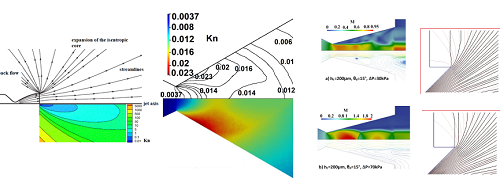 |
Ref: Sukesan, M. K., & Shine, S. R. (2021). Geometry effects on flow characteristics of micro-scale planar nozzles. Journal of Micromechanics and Microengineering, 31(12), 125001.
The main objective of the work is to examine the curvature effects of stenosis/dilatation region pertaining to left coronary artery. The hemodymamic features during the cardiac cycle is thoroughly examined. The influence of non-Newtonian effects of blood viscosity is found to be significant especially at stenosis regions. The flexible wall caused wall deformation and the associated flow and pressure wave propagation affecting WSS and pressure drop compared to the rigid wall. Flow recirculation is noticed at stenosis downstream locations and its strength increases with increased severity of the stenosis. The pressure drop, local WSS at stenosis centre, and radial velocity increase are significantly higher for stenosis cases and the effect is severe during peak diastole. Significantly lower WSS is noticed for the recirculation regions downstream of stenosis which can enhance the tendency for monocytes to attach to the endothelium. The radius of curvature of the stenosis is found to be the most sensitive parameter affecting the hemodynamic characteristics rather than the detailed geometry of the stenosis. The main effect of variation of artery wall stiffness is noted at recirculation regions present downstream of stenosis.
 |
Ref: Sandeep, S., & Shine, S. R. (2021). Effect of stenosis and dilatation on the hemodynamic parameters associated with left coronary artery. Computer Methods and Programs in Biomedicine, 204, 106052.
A human thermoregulatory model incorporating morphological details of Indians is established. The study investigated core and skin temperature variation during normal, hot and cold environments of western and Indian subjects as well as Indian male and female subjects. Effect of BMI, age, clothing and short-wave radiation on thermoregulation is also analysed. The most notable difference between western and Indian subjects is the delay in sweating and lower shivering rates under hot and cold environments respectively. Indian female subject showed slightly increased mean skin temperature and decreased sweating sensitivity compared to the male counterpart. In a hot environment, female thermoregulatory behaviour is characterized by a lower sweating rate, heat storage and increased mean skin temperature. Comparison between obese and lean Indian male subjects showed no significant difference in core body temperature, while the skin temperature is lower in obese subjects. The effect of clothing is found to be significant under cold environment. The research establishes the strong link between thermoregulatory response and morphology of humans in adverse environments and highlights the necessity of considering race specificity in human thermoregulatory models.
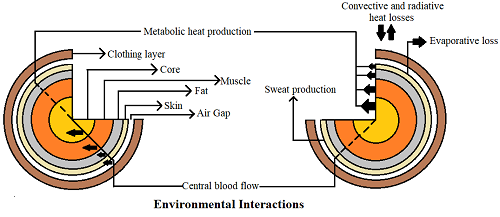 |
Ref: Karamapuri, K., & SR, Shine. (2021). Thermoregulation Model for the Reference Indian Adult. Journal of The Institution of Engineers (India): Series C, 102(4), 1073-1089.
Film cooling performance of a novel double jet configuration for gas turbine blade cooling is analysed. The proposed scheme has a primary compound angle hole along with a secondary hole compounded in the laterally opposite direction. The primary hole is provided with a trench at the coolant hole exit. It is seen that the proposed compounded double jet trench design (DJT) combines the advantages of compound angle, double jet and trenched configurations and provides better lateral and uniform coolant distribution, reduced jet lift off, and higher coolant attachment in the stream wise direction. The vortex mechanisms responsible for the coolant spread in near-hole and down stream regions are identified. The various flow structures that are responsible for higher effectiveness are compared with other configurations. Increase of turbulence produced significant increase in lateral effectiveness at higher blowing ratios. This effect was predominant at far downstream locations of the coolant exit plane.
 |
Ref: Priyatham, B. K., Pratyush, P. S. B., & Shine, S. R. (2021). Film cooling performance and flow field of compounded double jet holes with trench. Heat and Mass Transfer, 57(2), 189-203.
Defect free machining of Fibre Reinforced Polymer (FRP) Composites, crossing the challenges posed by anisotropic non-homogenous fibre-matrix system, is one of the important material processing requirements with a wide scope in industrial applications. Eccentric Sleeve Grinding (ESG) projected in this research is a unique strategy with progressive-intermittent cutting scheme for achieving minimal damage machined surfaces on FRPs. Progressively varying depth of engagement for active abrasive grains in the cutting zone with an intermittent and periodically repeating cutting pattern achieved through precisely controlled eccentric rotation of grinding wheel is the key highlight of ESG. Through this step-by-step cutting methodology, significant reduction in grinding force has been achieved on Carbon Fibre Reinforced Polymer (CFRP) composites under varying cutting conditions. Coordination of work feed with grinding wheel rotation is an important aspect to be considered for the minimization of scallops on FRP surfaces during ESG. A detailed theoretical model to guide the selection of work feed for a scallop free surface with reduced waviness, roughness and defects, with a demonstration of the associated graphical user interface, has been introduced in this research. Experiments reported to demonstrate the methodology and capability of intermittent-progressive cutting scheme may provide useful guidance for the adaptation of ESG in similar FRP machining applications. Studies organized in this research provides an in-depth practical insight towards a futuristic minimal damage grinding strategy for fibre reinforced polymer composites in critical functional applications.
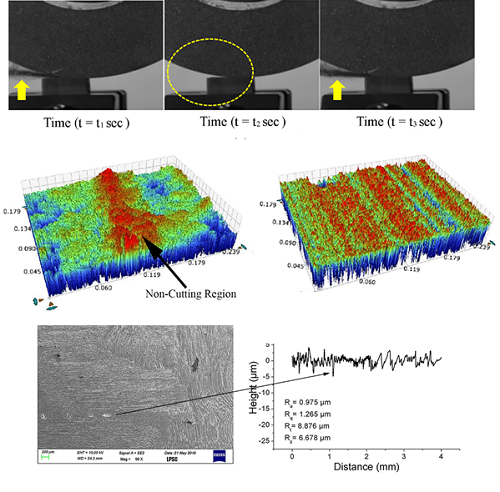 |
Figure 1: Concept of Surface Generation using Eccentric Sleeve Grinding
Ref: Danish Handa, V.S. Sooraj, Generation of scallop free machined surfaces in CFRPs with minimum waviness and defects using eccentric sleeve grinding, Journal of Materials Processing Technology, Volume 301, 2022.
Hypersonic air-breathing engines are constrained to do supersonic combustion because of the effects such as vibrational excitation, dissociation, and high total pressure loss when performing subsonic combustion. Supersonic combustion has its challenges due to the very low residence time and limited combustor length. The use of liquid fuel is an attractive option for supersonic combustion due to its high energy density. Liquid fuel can also be used as a coolant since hypersonic air-breathing vehicles produce high thermal loads. Additional challenges like atomization and evaporation are added along with mixing when liquid fuel is used, further complicating the supersonic combustion process. The pylon-aided injection can be a suitable option over other injection techniques because of its very low blockage area, better penetration for the same momentum flux ratio, and less total pressure loss than strut injectors. An experimental investigation has been carried out for the liquid injection behind a curved pylon at an angle of 60o in supersonic crossflow with Mach number 1.71. High-speed Schlieren and Mie scattering experiments were performed to evaluate the performance of curved pylon on the mixing of the liquid jet. Results show a better performance of curved pylon than the standard pylon. The penetration height of the liquid jet was 7.79% more for the curved pylon case as compared with the standard pylon case for the same momentum flux ratio. Further increase in the momentum flux ratio increased the penetration height to 15.53% more as compared with the standard pylon case. The spread area of the liquid jet was 17.42% more at x/dj = 25 and 25.97% more at x/dj= 40 for the curved pylon case than the standard pylon case for the same momentum flux ratio. The presence of counter-rotating vortices at the top of the liquid plume and in the near-wall region caused a higher spread area in curved pylon cases than in standard pylon cases.
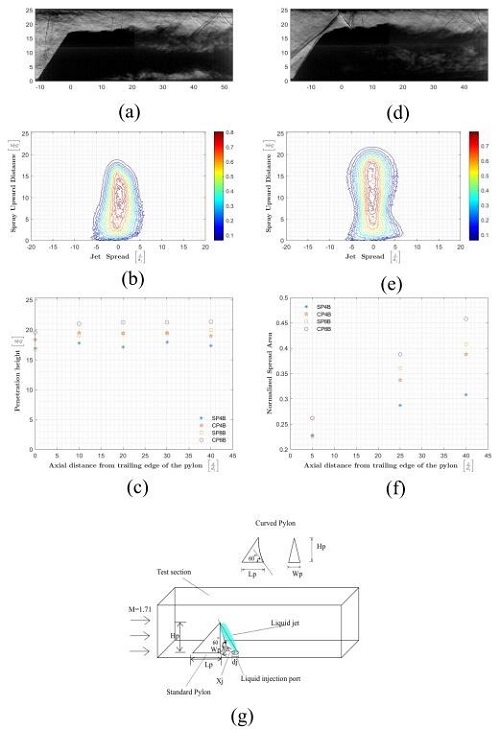 |
Instantaneous Schlieren images ((a),(d)) , Mie scattering images((b),(e)), Penetration height((c)) , and Spread area((f)), and the schematic ((g)) of Standard pylon((a),(b)) and Curved pylon((d),(e)) cases
Ref: Anbarasan Sekar, Mayukhmali Chakraborty, and Aravind Vaidyanathan. "Mixing characteristics of liquid jet injected behind a curved pylon in supersonic flow." Experimental Thermal and Fluid Science 134 (2022): 110570. https://doi.org/10.1016/j.expthermflusci.2021.110570
Biological composites such as bone, nacre, spider silk, and bamboo are known for their magnificent mechanical properties compared to their constituents at the basic level. Their fine mechanical properties such as high strength and toughness are attributed to various geometric and material properties. Of these, the staggering type and hierarchical structure are two essential geometrical properties responsible for the superior mechanical properties. Bio-inspired composites are artificial composites inspired from the design of biological composites. In our recent study, the mechanical properties of two hierarchical (2H) non-self-similar composites are analysed. The results show that the 2H non-self-similar composites possess much higher toughness than single hierarchical regular staggered (RSM) and stairwise staggered models (SSM) available in the literature. From Figure 2, it can be seen that on using two levels of non-self-similar hierarchy, the toughness can be amplified by a factor of more than 20 while keeping the strength at 20% of the platelet. But, a substantial reduction of elastic stiffness (less than 1% of the platelet stiffness) is observed at these values. A minimum stiffness of 2% of the platelet was kept and it is found that the toughness gain is still greater than 10 times irrespective of the type of staggering at both levels of hierarchy. Moreover, the non-self-similar composites seem to be characterized with much better strength for a similar toughness as that of self-similar 2H composites. Thus, these results indicate that 2H non-self similar composite may be used to obtain excellent toughness combined with good strength.
 |
Figure 2: a) Two Hierarchical Regularly Staggered Composite made with Stairwise Staggered Composite as platelet (2H RS); (b) Zoomed view of platelet with Stairwise Staggered Structure; (c) Two Hierarchical Stairwise Staggered Composite made with Regularly Staggered Composite as platelet (2H SR) (d) Zoomed view of platelet with Regularly Staggered Structure; Normalized strength vs normalized maximum toughness for (e) 2H RS model , (f) 2H SR model
Ref: Abhirami, A. J., & Anup, S. (2021). Mechanical properties of unidirectional bio-inspired composites with two non-self-similar hierarchical structures. Mechanics of Materials, 163, 104082.
The single-stage-to-orbit (SSTO) reusable launch vehicle is an emerging cost-effective, reliable, and environmentally friendly space transportation concept. The dual throat nozzle (DTN) is a typical altitude compensating nozzle that ensure adapted nozzle flow throughout the flight. The DTN has an inner primary nozzle and an outer secondary nozzle. Hence, it is capable of expanding different propellant/oxidizer combinations. The parallel burn operations in which the expansion of combustion products from both thrust chambers exhibits an interesting flow phenomenon in the DTN. The evolution of shock transition from regular reflection to Mach reflection and its reversal was captured. The shock transition hysteresis, its mechanism and control using wall heat transfer were also investigated. Results help improve the off-design operation of the DTN when it is used for a single-stage-to-orbit space mission.
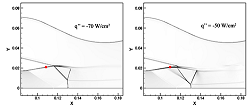 |
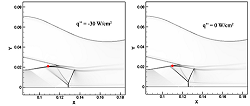 |
Ref: S. Jayakrishnan and M. Deepu Numerical study on the shock transitions during off-design operation of a dual throat thruster, Shock Waves, Vol. 31, 2021. https://doi.org/10.1007/s00193-021-01037-3
Fluid flow and heat transfer in regenerative cooling channels of rocket nozzles is a challenging research problem owing to its physical and geometrical complexities. Convergent–divergent rocket nozzles realize a varying wall heat transfer profile with a peak at its throat region. This creates an inherent difficulty in designing a proper single counter-current regenerative coolant path to maintain the nozzle wall within safe temperature limits during operation. Regenerative coolant channels with convex and concave lateral curvature improve heat transfer in the throat region of the nozzle compared to its parent counterpart without curvature. Secondary flow structures are formed due to the lateral curvature of the coolant fluid passages and are found to enhance the heat transfer considerably. The amplitude of lateral curvature plays a decisive role in thermo-hydraulic performance. More than a 20% increase in the average Nusselt number is possible by providing the double curvature to the coolant channel. The major advantage of a doubly curved coolant channel is that it provides effective wall cooling for a wider extent near the throat than other geometrical configurations
Ref: V. R. Adarsh, M. Deepu, and A. Salih, The effect of curvature on the heat transfer performance of regenerative cooling passages for a high-area ratio-nozzle, ASME Journal of Thermal Science and Engineering Applications, Vol. 14, 2022. https://doi.org/10.1115/1.4054211
Biogas issuing is a renewable and biodegradable clean energy source, that can be used to generate power and heat. The main component of both biogas and natural gas (NG) is methane diluted with inert gases like carbon dioxide (CO2). However, despite their advantages, it is not widely used because the composition can vary with the feedstock and therefore lead to uncertain combustion/engine performance and damage the hardware. This effect of composition variation (CO2 dilution) on the flame characteristics and pollutant emission is experimentally investigated in a partially premixed CH4 -air flame generated in a swirl and bluff body stabilized burner (IIST-GS2) placed inside a combustor. Optical and laser diagnostic methods are employed for this study. The non-premixed burner produced a converging-diverging flowfield at the burner exit and a lifted flame is produced at all test cases, with an upstream movement of the flame with decreasing global equivalence ratios (ϕg). Based on variations in ϕg, two flame stabilization modes – bluff body influenced and swirl stabilized – with a transition mode in-between is observed for the cases with (flame FB) and without dilution (flame FM). It is observed that the characteristics of the heat release zone are influenced by dilution, with the FB flames being longer and also less intense when compared to FM flames. Pollutant measurement at 30 mm downstream from the combustor exit highlighted the ultra-low NOx capability of the IIST-GS2 burner. CO2 dilution leads to a reduction in NOx emission due to both thermal and chemical effects. For ϕg ≥ 0.7 extreme low levels of CO and unburned hydrocarbons (UHC) are observed for both cases. For ϕg ≤ 0.6 the dramatic increase of both CO and UHC, may be due to the lower flame temperatures and shorter flame zone residence times, respectively.
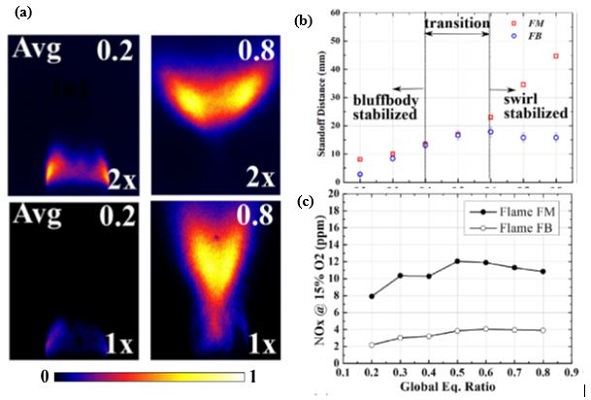 |
Ref: Aravind, S., Gohiyaa, R.K., Prakash, R.S., Sadanandan, R.: “Effects of CO2 Dilution on Partially Premixed CH4-Air Flames in Swirl and Bluff Body Stabilized Combustor”, Proceedings of the Combustion Institute (2021), Vol.38, pp. 5209-5217
The development of processing maps using the dynamic materials modelling (DMM) approach is a widely used method for choosing the appropriate process parameters for the thermomechanical processing of any material. A processing map depicts the variation of metallurgical power dissipation efficiency (η) and the material stability with changes in temperature and strain rate for a constant strain. Our study discovered that the conventional methodology to generate processing maps involved incorrect assumptions and computational errors which resulted in the production of unhealthy products using process parameters thus derived. To overcome this, we have designed a novel, efficient, and error-free algorithm to develop the processing map of any material using accurate domain-splitting and approximation techniques. We have also proposed the new binary instability parameter (β) that incorporates all instability conditions such that process parameters that should be avoided can be easily identified. This new algorithm will result in the production of healthy components using suitable process parameters.
 |
Figure 1: The processing maps of a magnesium alloy for 0.6 strain developed using (a) the proposed novel algorithm and, (b) the conventional methodology. The microstructure at point A which has a crack instability is shown in (c) which is only captured by the novel algorithm.
Ref: Neethu, N., Chakravarthy, P. Development of Processing Maps for Hot Deformation: Algorithm and Common Errors. Metall Mater Trans A 51, 3398–3402 (2020). https://doi.org/10.1007/s11661-020-05817-x